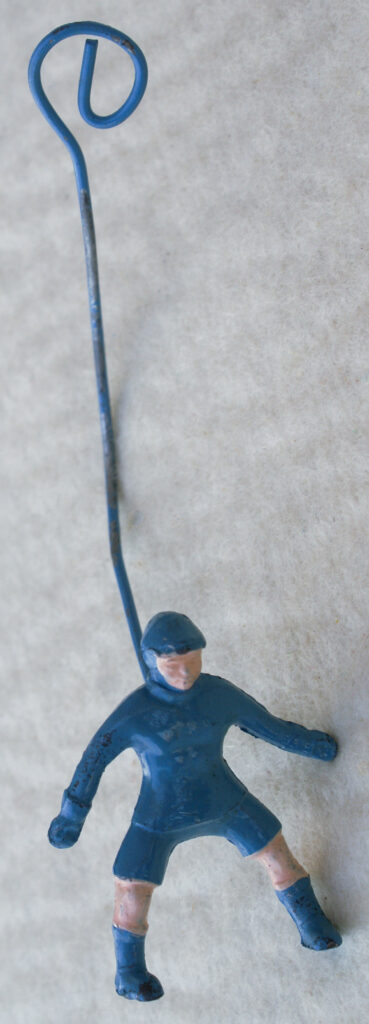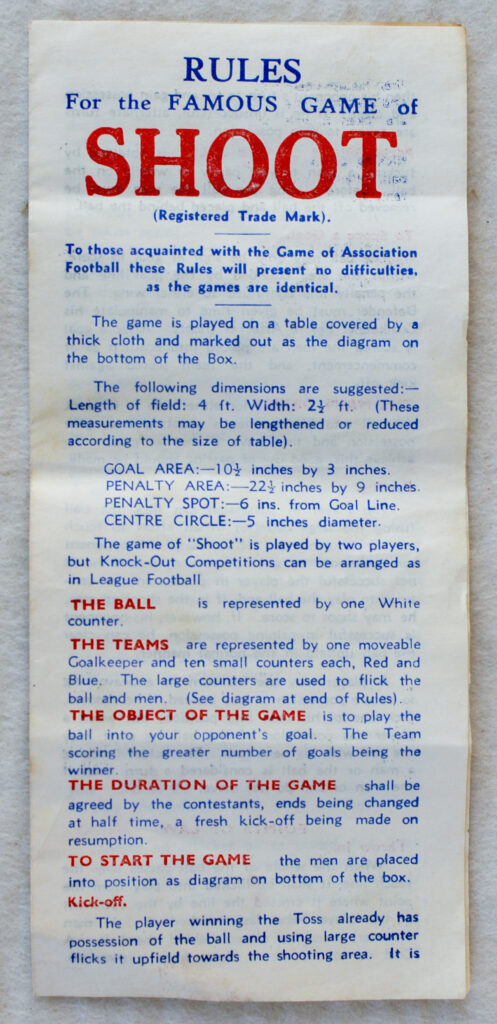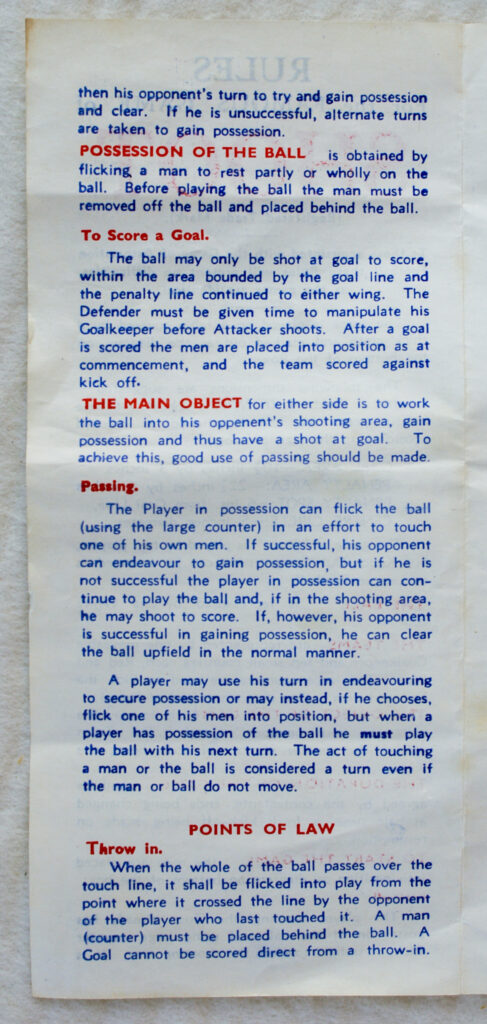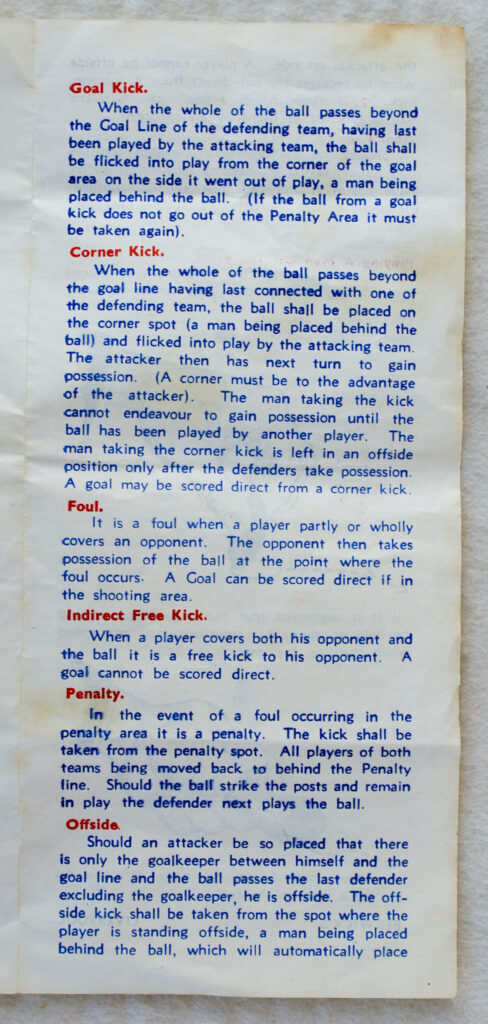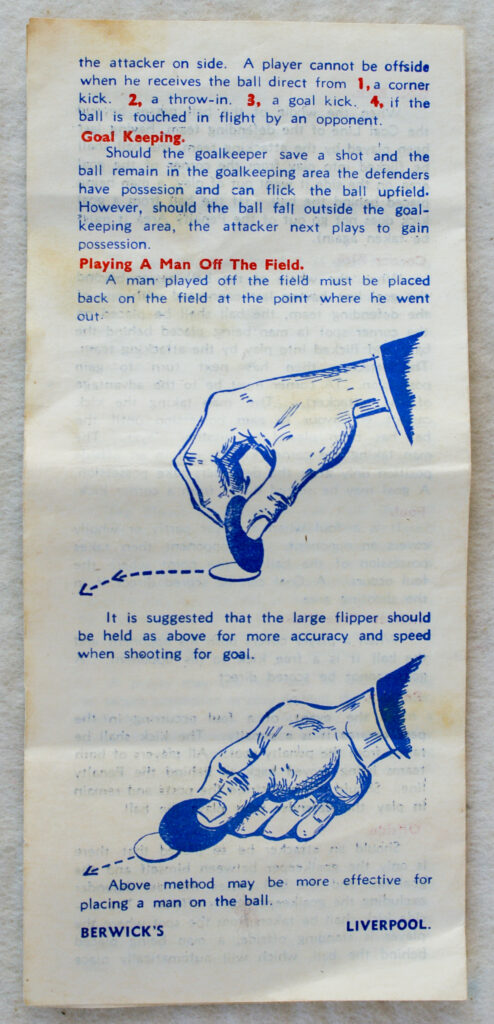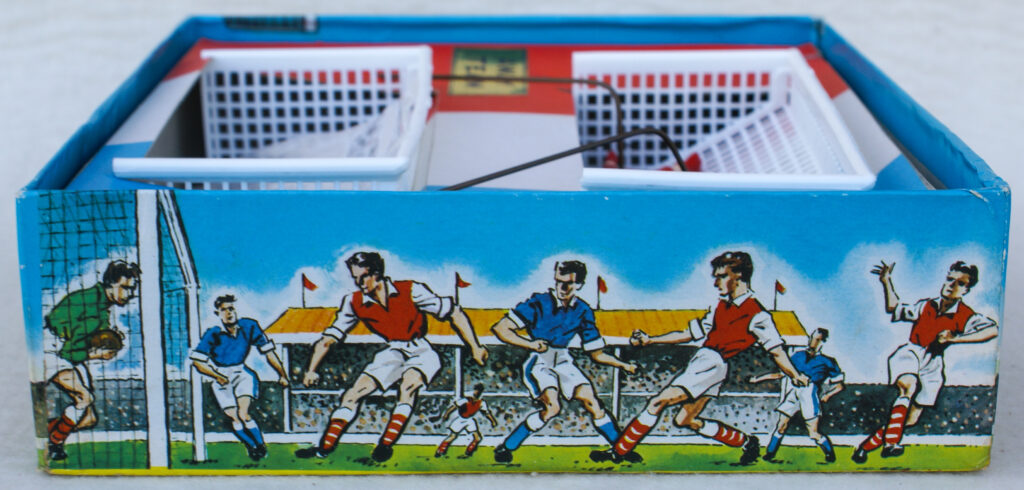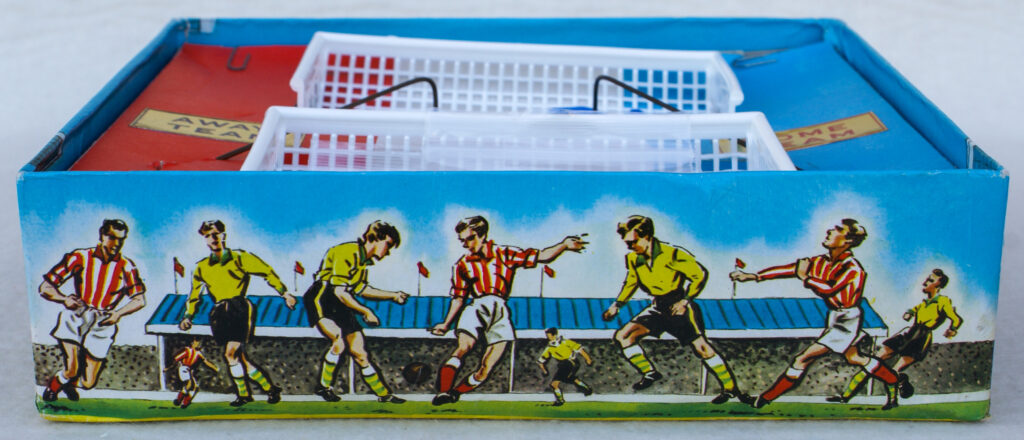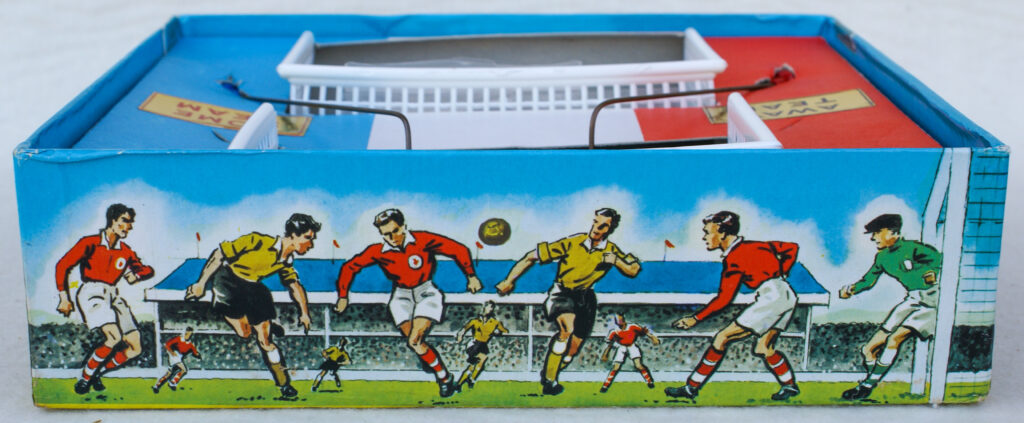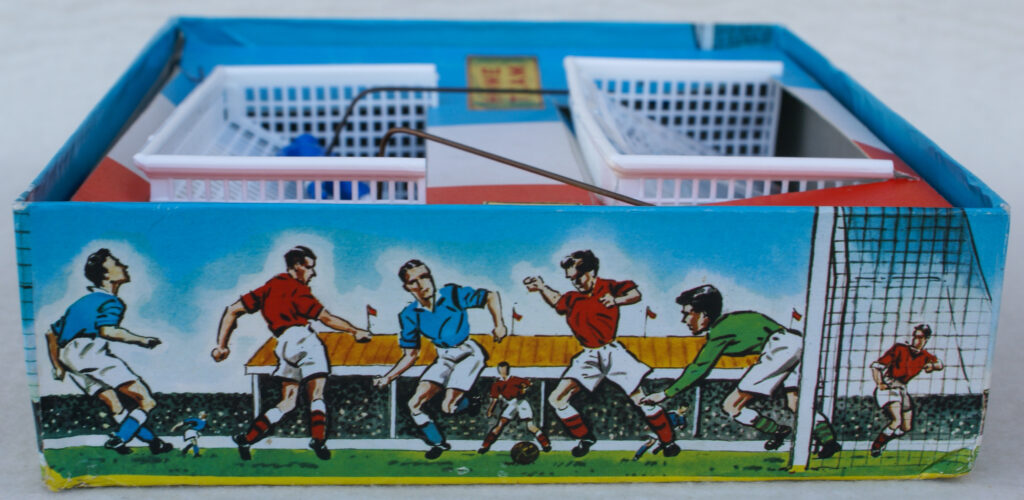A slew of sports succumbed to tiddlywinks frenzy, starting soon after 1890, with many continuing on to this very day.
These most brisk and giddy-paced times.
William Shakespeare, Twelfth Night, Act II, iv, 6.
Tiddlywinks • Quoits
What are quoits? Simply put, quoits are round rings—rings with hollow centers. Indeed, they can be flicked using squidgers toward various targets, pretty much in the same way that solid disc winks can be flicked with the same squidgers. The original sport of quoits involves throwing a ring, typically made of braided rope, iron, or rubber, with the aim to land closest to or over a stake in the ground.
Quoits tiddlywinks can be quite fun to play. Here we present a number of tiddlywinks games that are devoted to using quoits in their play.
Jasper Hamlet Singer of New York City copyrighted an engraving (as indicated by Eng. on the copyright card) for “Tiddledy Winks Quoits” on 31 January 1891, as copyright number 4418 in the year 1891 (noted as “W” for copyrights during that year). Given that it was an engraving, the copyright would be for an illustration used on the cover or inside the game rather than the rules.
J. H. Singer (1846–1922) was a prolific maker of quality games and a book publisher until his firm was granted bankruptcy in July 1902. He was the son of Isaac Merritt Singer, famous for founding the Singer Sewing Machine Company.
![[+template:(Tucker Tw ID • [+xmp:title+] — publisher • [+iptc:source+] — title • [+xmp:headline])+]](https://tiddlywinks.org/wp-content/uploads/2023/01/1891-12-01-patented-by-Dock-D-Harr-patent-no-464098-559x1024.jpg)
A few days later, on 5 February 1891, Dock D. Harr of Belmond, Iowa, applied for a patent (granted as US patent # 464,098 on 1 December 1891) for a GAME-BOARD which involves:
[…] placing a ring E’ upon a shooting cushion D and bearing hard upon the edge of the ring with the shooting implement in a downward direction, as indicated by the arrow. This will cause the ring to spring forward. […] The object of each player is to shoot his rings so that they fall over the central pin in the cup.
If you have never tried shooting a metal or plastic or wooden or vegetable ivory ring (a quoit) with a disc, you might not think that it would fly through the air very well, but in fact, it does—very well. This patent was approved on 1 December 1891.
And in the meantime, Dock. D. Harr also copyrighted “Quti-Quoits” on 9 November 1891. He and his brother John L. Harr certainly branched out after having patented a Type Writing Machine the year before. Dock also garnered a design patent for a bottle shape in 1891.
But wait! The American Stationer of 26 February 1891 illustrates Ring-A-Peg, a tiddlywinks quoits game, in which:
[…] a circular board containing a number of upright pegs is placed on a cloth in the centre of the table. The game may be played by two, three or four persons, each player being provided with five rings made of bone brightly colored and a square piece of the same material called the ‘ringer,’ the latter being used to snap the rings upon the upright pegs. [...]
The inventor of the game is John H. B. Trainer, a young man who has been connected with the book, stationery and fancy goods trades ever since he was a small boy.
The manufacturers are Geo. B. Leiter & Co., Williamsport, Pa.
George B. Leiter, then of Norristown, Pennsylvania, registered a U.S. trademark for Ring-a-Peg on 23 September 1924, 33 years after the claimed first use of the mark on 13 May 1891.
The American Stationer article above does not mention E. I. Horsman. However, curiously enough, E. I. Horsman came out with the exact same Ring-A-Peg, then marked with “PAT. APPLIED FOR”, including his “E.I.H” in a diamond mark. (This U.S. patent has not yet been located.) The Ring-A-Peg game is devoted to shooting rings as tiddlywinks onto peg targets using square squidgers.
Note that in addition to E. I. Horsman producing the Ring-A-Peg game originated by Geo. B. Leiter, E. I. Horsman also produced Lo Lo The New Parlor Croquet Game that was also made by Geo. B. Leiter & Co.
![[+template:(Tucker Tw ID • [+xmp:title+] — publisher • [+iptc:source+] — title • [+xmp:headline])+]](https://tiddlywinks.org/wp-content/uploads/2022/07/HOR-04v2-DSC00300-768x762.jpg)
Rick Tucker Tiddlywinks Collection
Licenseable per Creative Commons CC BY-SA 4.0
![[+template:(Tucker Tw ID • [+xmp:title+] — publisher • [+iptc:source+] — title • [+xmp:headline])+]](https://tiddlywinks.org/wp-content/uploads/2022/07/HOR-04v2-DSC00310-1024x583.jpg)
wooden target, winks (quoit rings), squidger (square bone)
Rick Tucker Tiddlywinks Collection
Licenseable per Creative Commons CC BY-SA 4.0
RING -A-PEG.
Rules and Directions for Playing.
This game may be played by two, three or four persons.
The board should be placed upon a table or stand covered with a thick cloth. Where four play, each player is supplied with four rings of one color, and a square, the object being to snap the rings from the table on to the board and if possible over a peg. To do this he must place the edge, not corner, of a square on the top of a ring on the edge neat him, press lightly, drawing the square towards him. When it slips off the ring, the latter will fly towards the board. Where two play, each one can take 8 rings and play with two colors. The players all play in succession towards the left, each having one snap at a time until all the rings are on the board. A ring over a peg in the outer circle counts five. A ring over a peg in the inner circle counts ten. A ring over the center or king peg counts twenty-liveTHE PRIMARY GAME, FOR CHILDREN,
Is played as follows: The rings are all snapped upon the board, in the order as specified above, and the player whose rings count the most, is the winner. A tie is decided by the contestants alternately snapping one ring until one becomes the winner.THE ADVANCE GAME
Is more intricate, and is as follows: 1st.—The game is placed at two hundred. 2d.—When all the rings are played on the board, it is called a “Board,” and the result counted and placed to the credit of the contestants. 3rd.—As many “Boards” are played as are necessary for one to secure the game. 4th.—When a player succeeds in playing two of his rings over the same peg in the outer circle he is entitled to take one of them and place it over a peg in the second circle and in doing so makes what is denominated “A March.” If the doublet is made on the inner circle, he can “march” to the king peg. 5th.—When a ring is played or “marched” over an opponent’s, the top one counts. If a third is added, making a triplet, the top and bottom ones count. If a fourth one is added (all being opponents,) making a quartet, the top and the two bottom ones count, the general rule being that a top ring destroys the value of the one immediatl[e]y underneath it, and revives the value of the ones that may be below that one. 6th.—In making a march from the outer circle a player has the choice of pegs on the inner circle, and may top any opponent that may be most to his advantage, or, if he himself already occupies a peg in that circle, can, at his option, doublet that instead, and move on to the center peg which move is denom[in]ated a “grand march.” 7th.—A march cannot be made from two like rings over the same peg when they are separated by one or more opponent’s rings. 8th.—Contestants must count their positions through each “Board,” and especially towards the close of the game, as the values are constantly changing, top ones going under and under ones coming to the top, so that he is ready to cry “Peg” so soon as his count reaches 200. If his right to the game is challenged, his count may be reviewed, and if found defective, he loses, and the next one out is the winner.Tiddlywinks • Bowling
The first appearance of a bowling variant of tiddlywinks appears in a copyright by William T. Maney on 6 March 1891 for Directions for playing Tiddledy Wink Ten Pins.
However, separately, William Sowdon of New York City claimed a trademark for TIDDLEDY WINK TEN PINS, which was in use by him since January 1891 and registered on 13 October 1891 in the U.S. as trademark 20,225. In addition, William Sowdon copyrighted his rules for Tiddledy Winks & Tiddledy Wink Tenpins on 28 August 1891. William Sowdon partnered with Edgar O. Clark in the game company, Clark & Sowdon, until Sowdon’s death on 2 April 1899, when the company was located at 342 West 14th Street in Manhattan.
Three slightly different versions of TIDDLEDY WINK TEN PINS are shown below. The first one does not indicate a trademark; the second one has “Trade Mark” above the title; and the third one shows “Trade Mark” below the title. No publisher name appears on any of these games.
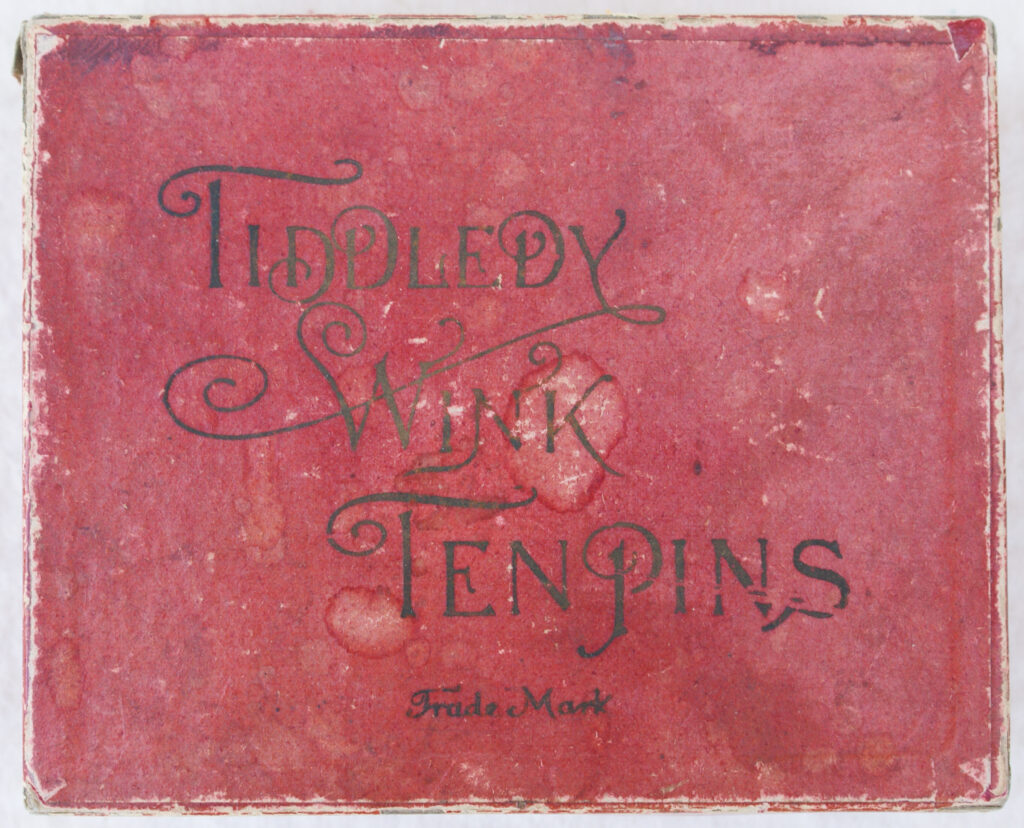
red cover, "Trade Mark" below title
Rick Tucker Tiddlywinks Collection
Licenseable per Creative Commons CC BY-SA 4.0
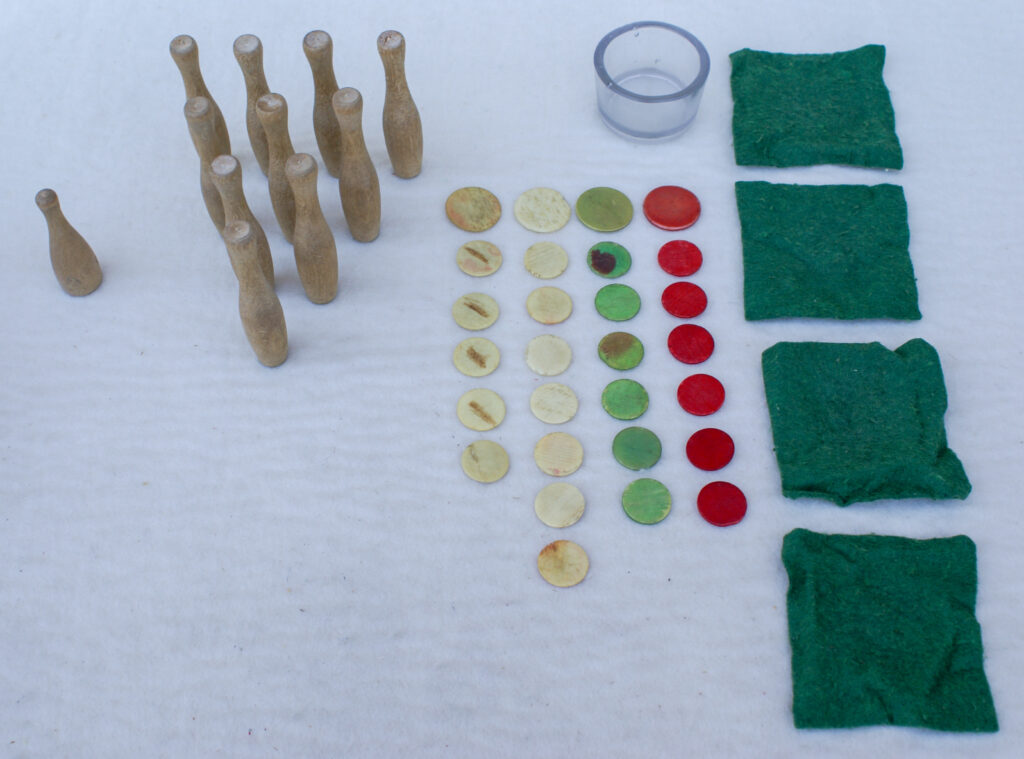
contents
Rick Tucker Tiddlywinks Collection
Licenseable per Creative Commons CC BY-SA 4.0
Parker Brothers sold HOP-SCOTCH TIDDLEDY WINKS for around 23 years starting in 1891, using several different cover illustrations during that timeframe.
"Hop-Scotch Tiddledy Winks." one of the most popular elaborations of that game, is an article of especially large scale.
“COPYRIGHTED 1891” appears at the lower right of the cover of most games, though on many of the editions, the “9” is reversed and some people mistakenly read it to be “1881”. The cover also claims a “TRADE MARK” and “PATENT APPLIED FOR” though neither have been found in official U.S. records.
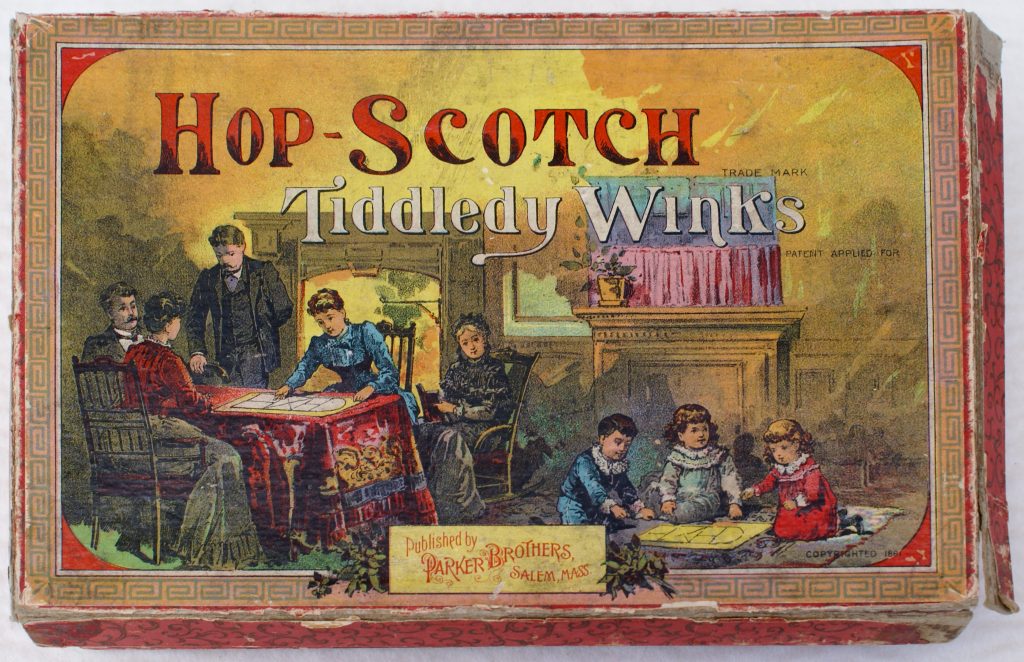
Rick Tucker Tiddlywinks Collection
Licenseable per Creative Commons CC BY-SA 4.0
In addition, Parker Brothers published a game called Progressive Hop Scotch Tiddledy Winks, which appears in the The Adult Party Game and Evolving to a Children’s Game chapter.
A number of early French tiddlywinks games include a target with a hopscotch-style layout, some with hell and paradise represented on a hopscotch court, and others showing Paris and New York airports on a hopscotch-styled court.
Tiddlywinks • Croquet
F. H. Ayres came out with Croquet Spoof in England in the early 1890s, as shown in an earlier chapter of this online book.
McLoughlin Brothers copyrighted the rules for “Tiddledy Wink Croquet” in the U.S. on 6 April 1891, # 12421 (1891 W). I have not yet seen an actual copy of this game from McLoughlin Brothers.
![[+template:(Tucker Tw ID • [+xmp:title+] — publisher • [+iptc:source+] — title • [+xmp:headline])+]](https://tiddlywinks.org/wp-content/uploads/2023/01/1891-US-Copyright-Office-item-copyright-card-by-McLoughin-Bros-title-Tiddledy-Wink-Croquet-id-12421-1024x665.jpg)
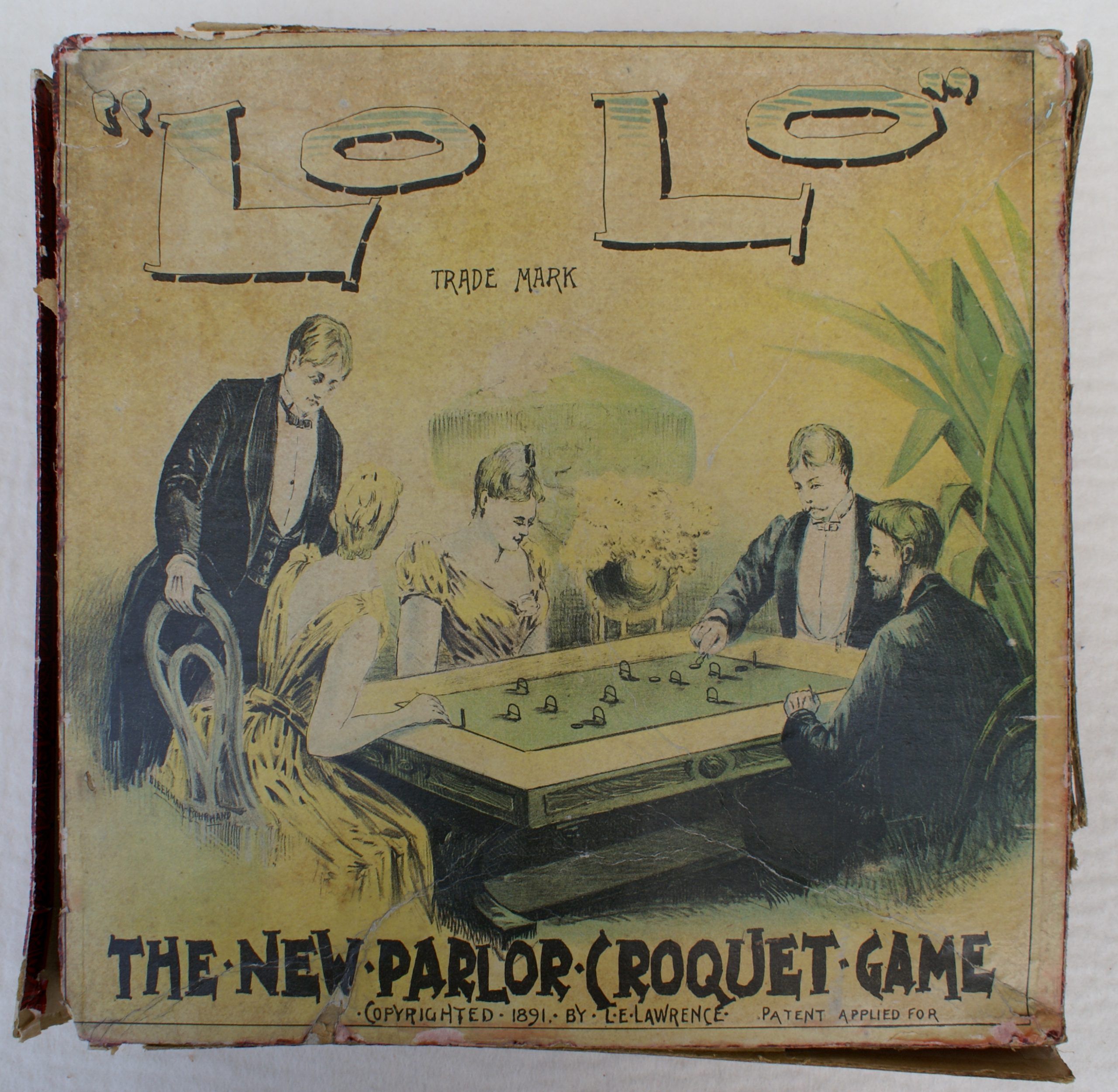
Rick Tucker Tiddlywinks Collection
Licenseable per Creative Commons CC BY-SA 4.0
In the 1890s, Adolf Engel of Berlin in Germany published a game simply called Croquet. While the cover depicts well-dressed ladies and gentlemen playing the real game of croquet on the ground outside with mallets, wickets, and balls, this game is actually a tiddlywinks version of the croquet, as evidenced by the illustration on the rules and the equipment provided, which includes a felt mat with wickets affixed, and flat, round squidgers and winks to be shot around on the felt and through the wickets. The rules are written in German.
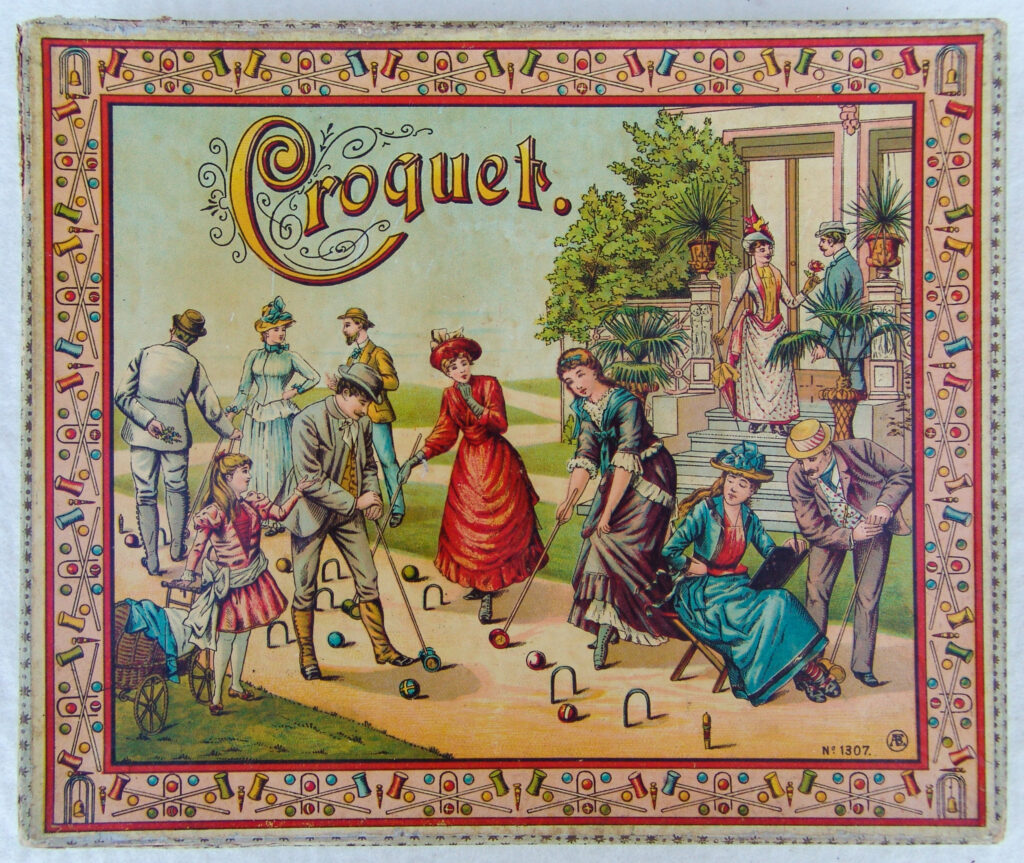
title • Croquet
publisher • Adolf Engel (Berlin)
date • estimated in the 1890s
item • game cover
photograph by • Rick Tucker
original in • Tucker Tiddlywinks Collection
licenseable • per Creative Commons CC BY-SA 4.0
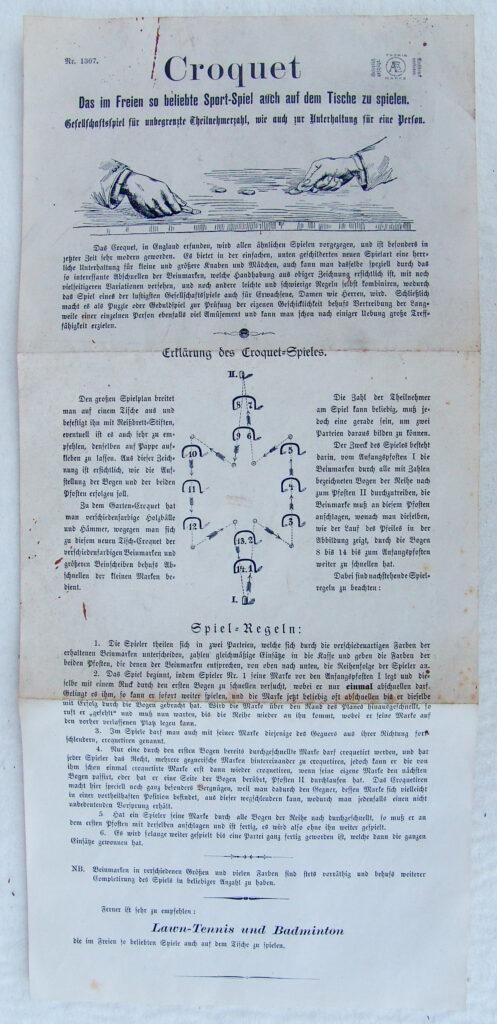
title • Croquet
publisher • Adolf Engel (Berlin)
date • estimated in the 1890s
item • rules
photograph by • Rick Tucker
original in • Tucker Tiddlywinks Collection
licenseable • per Creative Commons CC BY-SA 4.0
Zulu Toy Manufacturing Company of Battle Creek Michigan produced Tiddledy Winks Croquet, © 1926, with the cover depicting pixies playing tiddlywinks using a very large yellow squidger to shoot winks while a grasshopper and beetle watch from their perch among mushrooms. The same cover artwork was used in another game called Tiddledy Winks Complete, which contains totally different contents and was not a croquet version. The rules describe a shot corresponding to the boondock shot made in the modern competitive tournament game, and also accounts for what happens when a wink goes off the felt playing surface:
8. When a player's wink rest[s] on, or touches an opponent's wink, the player whose wink is resting on or touching the opponent[']s wink has the privilege of snapping his opponent's wink away thereby making his opponent get farther away from the line he is trying to hop over, and also gets another shot. If the wink is snapped off of the felt entirely, the player can bring his wink back to the edge of the felt, nearest the place where it went off.
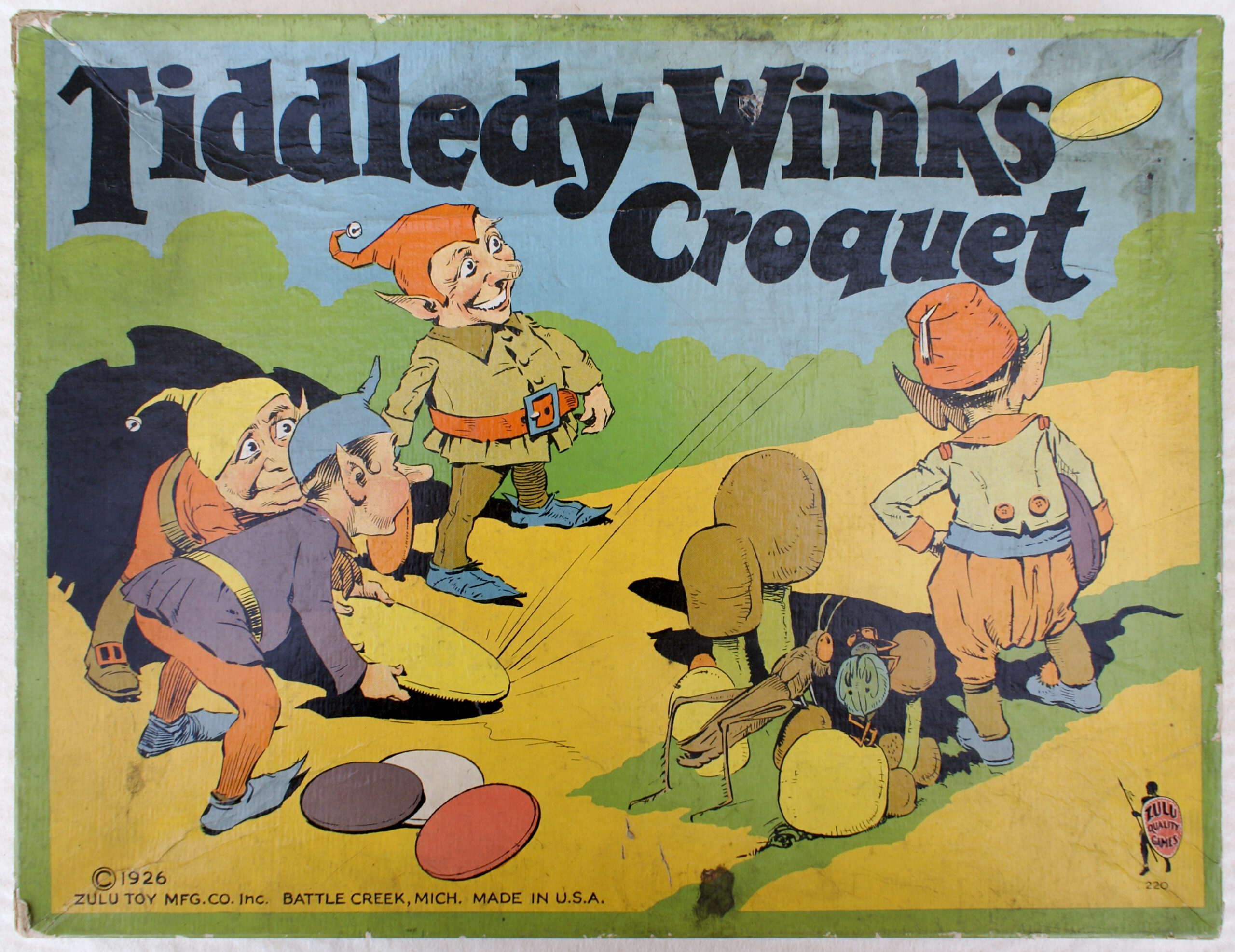
title • Tiddledy Winks Croquet
publisher • Zulu Toy Mfg. Co. (Battle Creek, Michigan)
date • © 1926
item • game cover
photograph by • Rick Tucker
original in • Tucker Tiddlywinks Collection
licenseable • per Creative Commons CC BY-SA 4.0
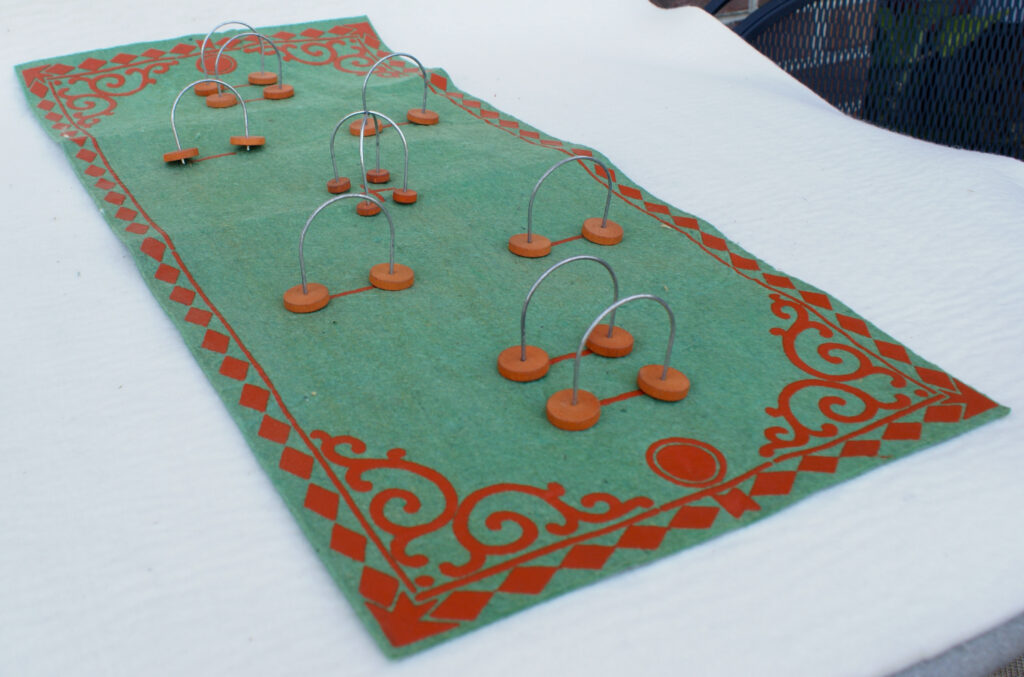
title • Tiddledy Winks Croquet
publisher • Zulu Toy Mfg. Co. (Battle Creek, Michigan)
date • © 1926
item • rules under box lid
photograph by • Rick Tucker
original in • Tucker Tiddlywinks Collection
licenseable • per Creative Commons CC BY-SA 4.0
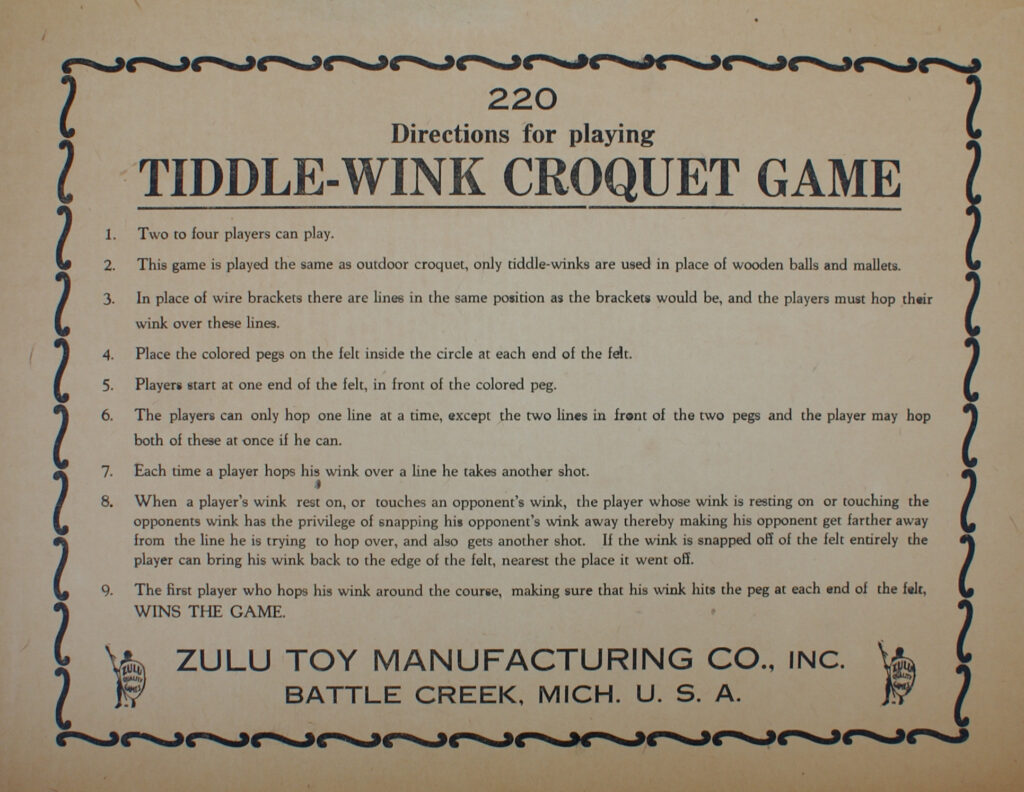
title • Tiddledy Winks Croquet
publisher • Zulu Toy Mfg. Co. (Battle Creek, Michigan)
date • © 1926
item • rules
photograph by • Rick Tucker
original in • Tucker Tiddlywinks Collection
licenseable • per Creative Commons CC BY-SA 4.0
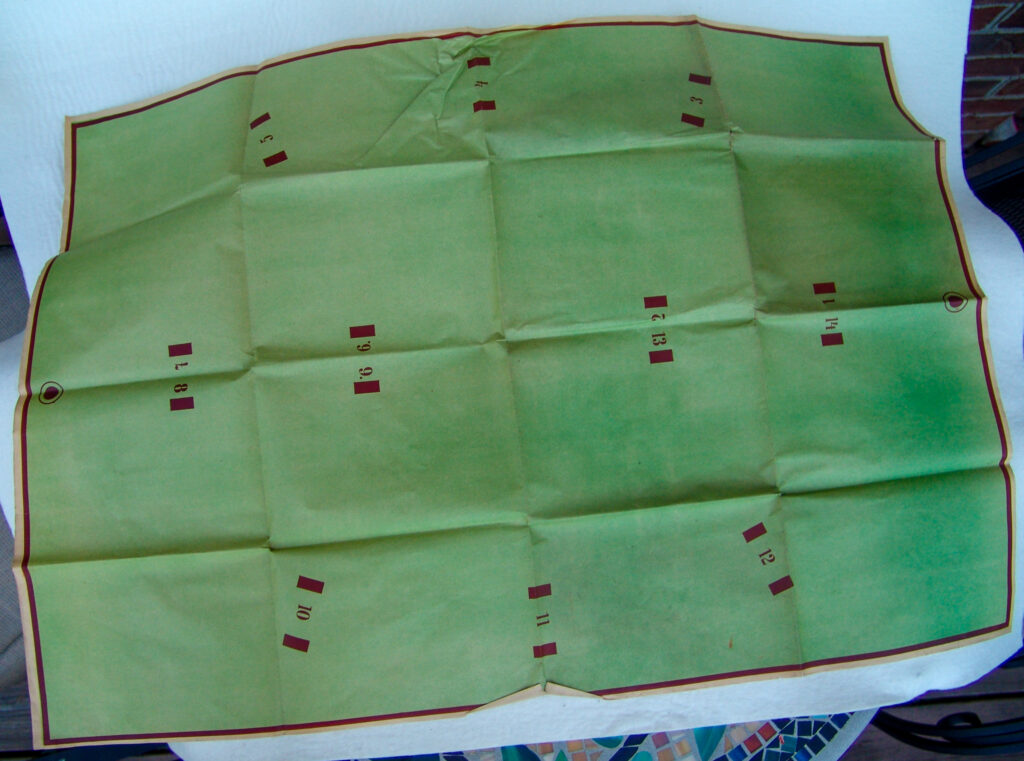
title • Croquet
publisher • Adolf Engel (Berlin)
date • estimated in the 1890s
item • felt playing surface
photograph by • Rick Tucker
original in • Tucker Tiddlywinks Collection
licenseable • per Creative Commons CC BY-SA 4.0
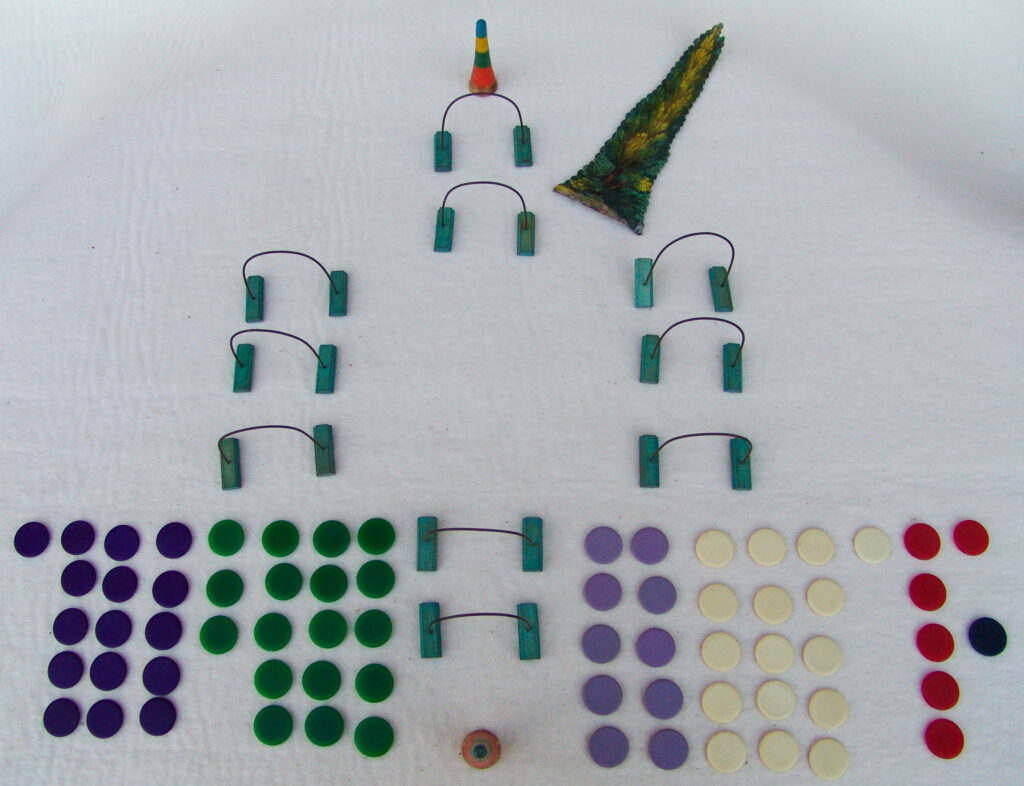
title • Croquet
publisher • Adolf Engel (Berlin)
date • estimated in the 1890s
item • winks and wickets
photograph by • Rick Tucker
original in • Tucker Tiddlywinks Collection
licenseable • per Creative Commons CC BY-SA 4.0
Tiddlywinks • Cricket
The sport of cricket, with wickets and bowlers and fielders, has been traced back to at least the year 1611.
THE GAME OF FLIRTING CRICKET is AN INDOOR GAME OF SKILL AND CHANCE COMBINED. No publisher name appears on this British game from 1892. The advertisements shown below also mention FLIRTING FOOTBALL, though I’ve not seen that particular game. An advertisement appearing in the Jedburgh Gazette on 12 November 1892 also lists a FLIRTING TENNIS game along with other tiddlywinks games: Croquet Spoof, Milkmaid, Pagoda[h], Chronowinks, and Spoof Golf. The Flirting games were still available for sale in 1901, as listed in an advertisement in the Wigton Advertiser.
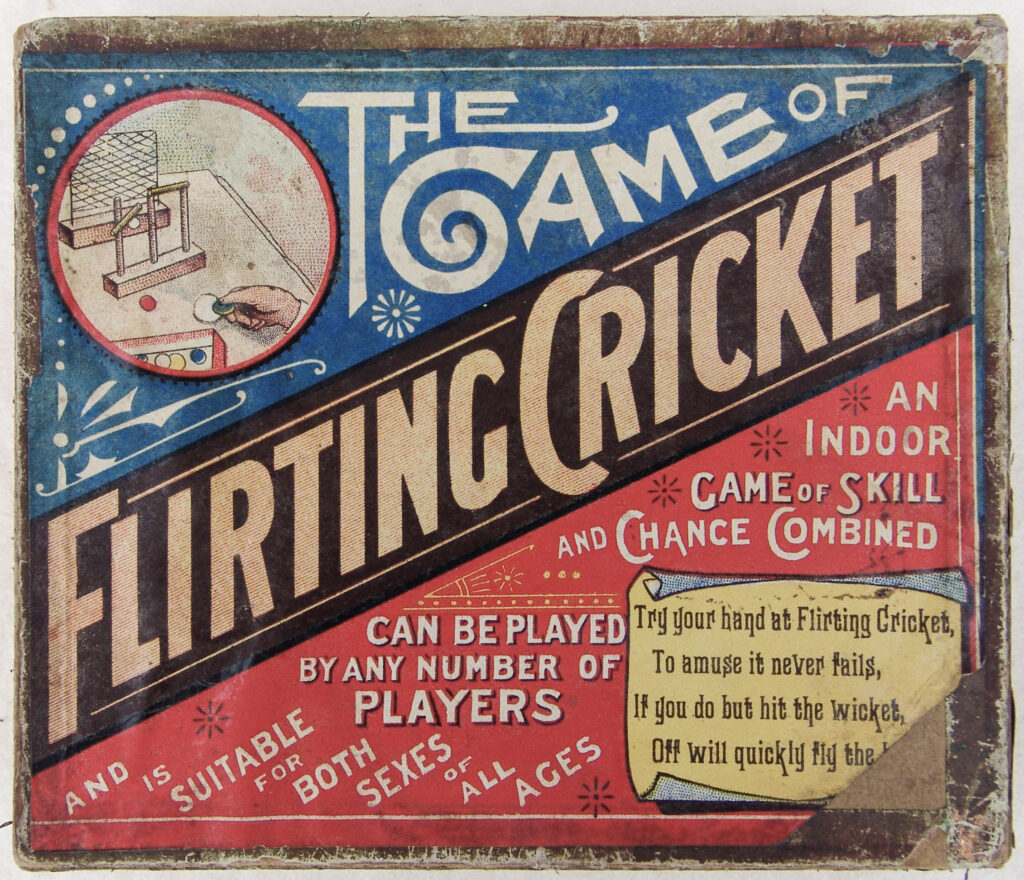
title • THE GAME OF FLIRTING CRICKET
publisher • Unknown (British)
item • cover
photograph by • Rick Tucker
original in • Tucker Tiddlywinks Collection
Licenseable per Creative Commons CC BY-SA 4.0
![[+template:(Tucker Tw ID • [+xmp:title+] — publisher • [+iptc:source+] — title • [+xmp:headline])+]](https://tiddlywinks.org/wp-content/uploads/2023/01/1892-11-11-North-Eastern-Daily-Gazette-Middlesbrough-England-page-1-col-5-item-ad-for-Flirting-Cricket-from-BNA-BL_0000159_18921111_002_0001-crop-to-ad.jpg)
![[+template:(Tucker Tw ID • [+xmp:title+] — publisher • [+iptc:source+] — title • [+xmp:headline])+]](https://tiddlywinks.org/wp-content/uploads/2023/01/1892-11-12-Jedburgh-Gazette-England-page-1-col-5-item-ad-wiith-Flirting-Cricket-Tennis-and-Football-from-BNA-BL_0002162_18921112_037_0001-crop-to-ad.jpg)
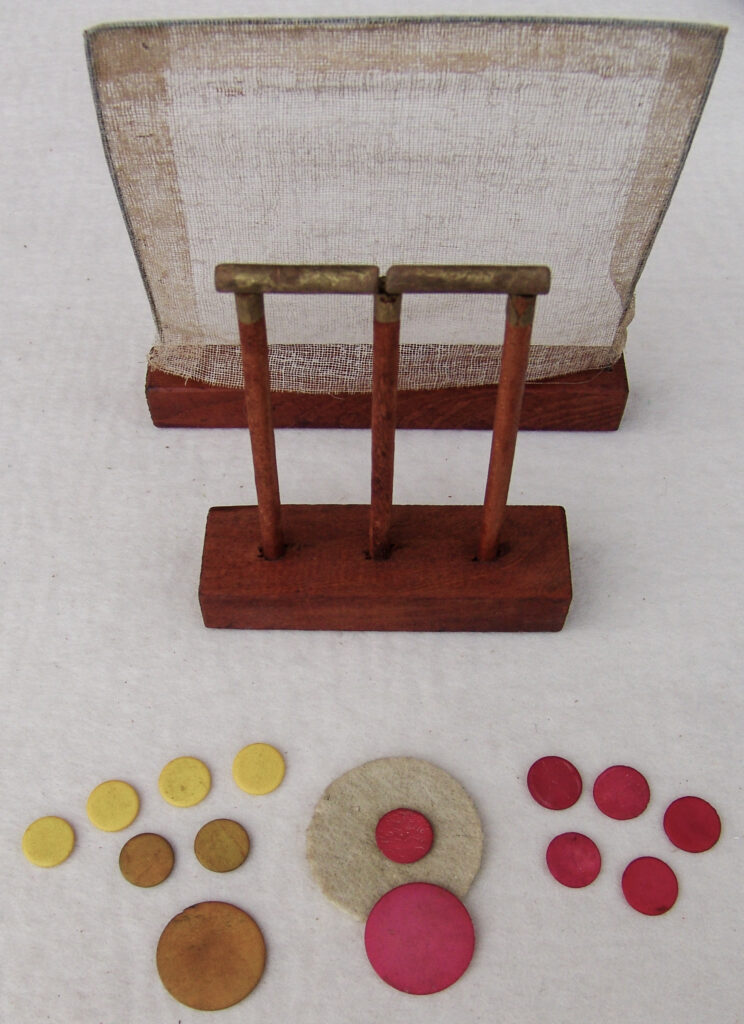
title • THE GAME OF FLIRTING CRICKET
publisher • Unknown (British)
item • contents
photograph by • Rick Tucker
original in • Tucker Tiddlywinks Collection
Licenseable per Creative Commons CC BY-SA 4.0
The game CRICKET • E • WINKS was published by House-Martin in England. While undated, it is estimated to be from the 1960s.
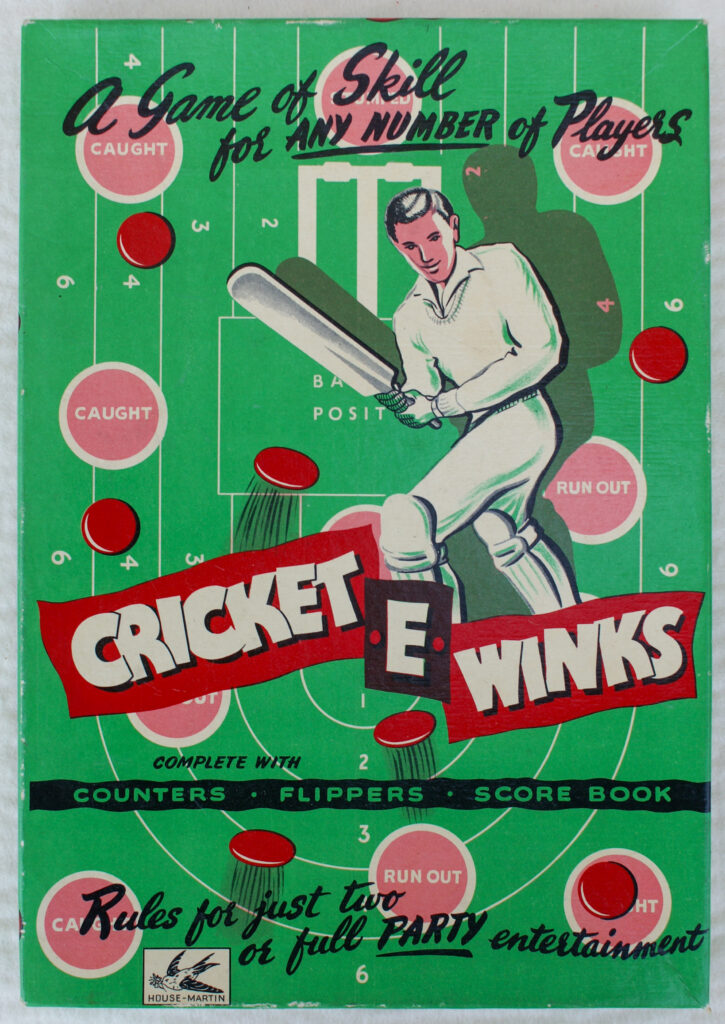
title • CRICKET • E • WINKS
publisher • House - Martin
item • cover
photograph by • Rick Tucker
original in • Tucker Tiddlywinks Collection
Licenseable per Creative Commons CC BY-SA 4.0
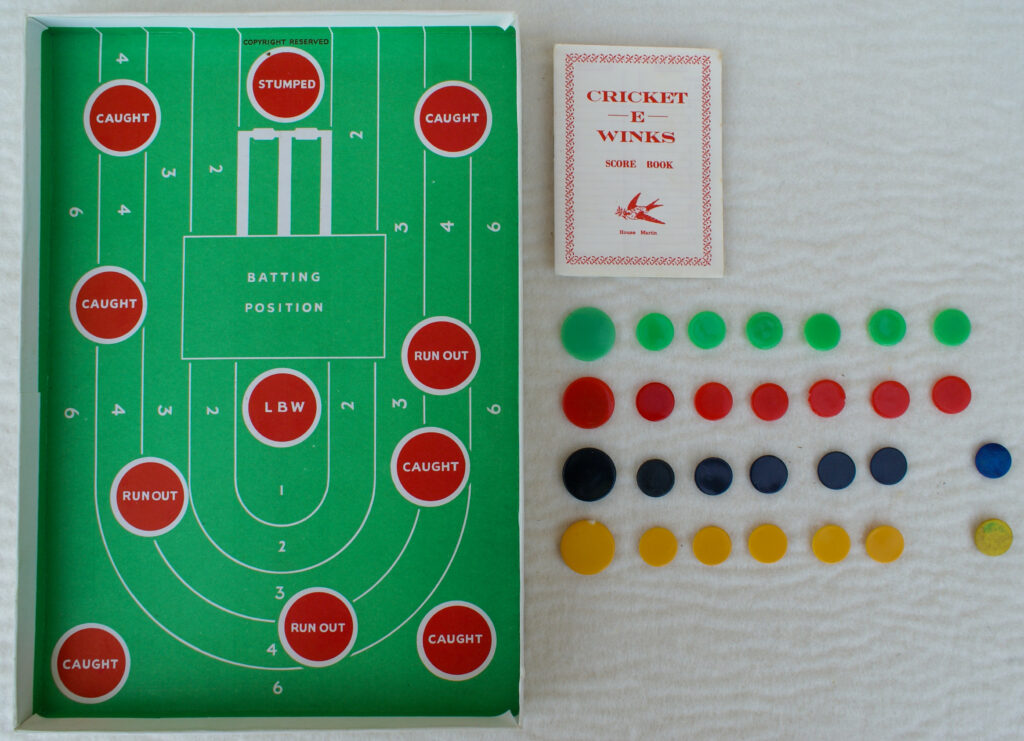
title • CRICKET • E • WINKS
publisher • House - Martin
item • contents
photograph by • Rick Tucker
original in • Tucker Tiddlywinks Collection
Licenseable per Creative Commons CC BY-SA 4.0
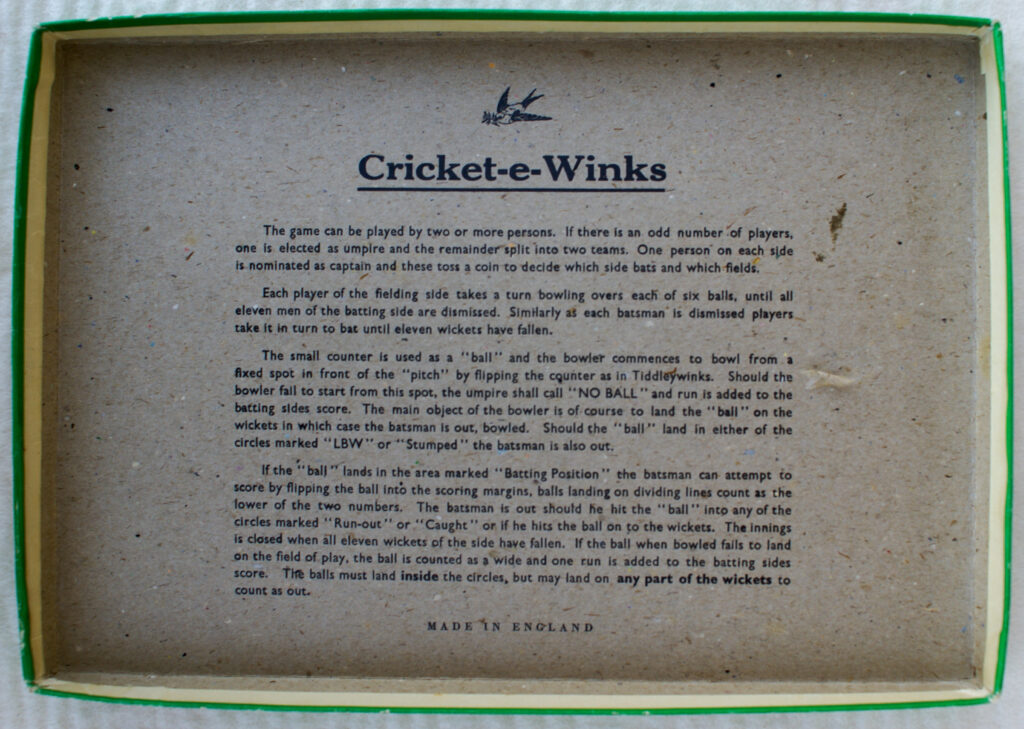
title • CRICKET • E • WINKS
publisher • House - Martin
item • rules
photograph by • Rick Tucker
original in • Tucker Tiddlywinks Collection
Licenseable per Creative Commons CC BY-SA 4.0
Tiddlywinks • Association Football
1863 was a pivotal year in the history of sport of association football, the international game played on a pitch. That was the year The Football Association was formed in England.
An early tiddlywinks football game called SHOOT was produced in a horizontal box by F. Denye of the Star Yacht Works in Birkenhead, England, This game was “Manufactured Under Licence” as noted on the back of each of the metal mesh and cardboard goals. The front of each goal indicates that this game was // Regd. “SHOOT” Trade Mark //. In addition to building yachts, Denye’s company was a “Toy Manufacturer“, as noted in a photograph on the front of its factory. The company was founded by Franz-Marie Denye in 1922. This game is estimated to be dated in the 1930s. Note that each of the goalies in this game are standalone and do not have metal rods attached to them in the rear for players to control their movements (unlike a subsequent game). The cover of this game indicates that it was // REGISTERED By The Author of “IMPEDEE” //. The name IMPEDEE was trademarked by someone named Harrop in 1897 per the British Trade Marks Journal (1897, page 932); the game IMPEDEE appears in an 1899 advertisement in the Edinburgh Evening News and a 1900 advertisement for games in the Dundee Courier.
Another tiddlywinks football game with the same title of SHOOT came out in a box with a vertical cover as shown below, also with no publisher name appearing on the game. The illustration on this game’s cover is pretty much the same as the SHOOT game shown above that has Tucker Tw ID • SVW-01c1. But this particular game has no publisher name marked on it, though, like the game above, the cover indicates that it was // REGISTERED By The Author of “IMPEDEE” //. Also note that the metal goalies included in this game have a metal rod attached to each of them from the rear that can be manipulated by a player via a sliding hole in the rear of the goal. The previously identified game did not. include metal rods attached to each goalie.r
While the previous Shoot tiddlywinks football games were produced by unnamed game publishers in England, most of the remaining tiddlywinks football games were produced by the British game company, Berwick.
The following “SHOOT” game depicts images of famous footballers along with quotes from them on the game’s aprons.
- Tommy Lawton (played professionally from 1936 to 1956)
- Stanley Matthews (played 1932 to 1965)
- Denis Compton (played football from 1932 to 1950; also played cricket)
- Tommy Jones
The “5/11” marked on the Stanley Matthews apron indicates the price for this game: 5 shillings and 11 pence. The goals included in this game are made of metal mesh and cardboard borders. The goalkeepers are metal (in red for one side, blue for the other) with metal handles to manipulate the pieces. This game is estimated to be from the 1950s. A 1955 newspaper advertisement for SHOOT is shown below.
The cover illustration on the following Berwick “SHOOT” MATCH SET tiddlywinks football game is similar to the previous one. However, the goals in this game are entirely plastic, in white, and the goalkeepers are also plastic (in red/pink and blue/white) attached to metal rods for players to bold in playing the game. No footballers are shown endorsing this game. This game is estimated to be from the late 1960s or early 1970s. Berwick was located in Birkenhead, England.
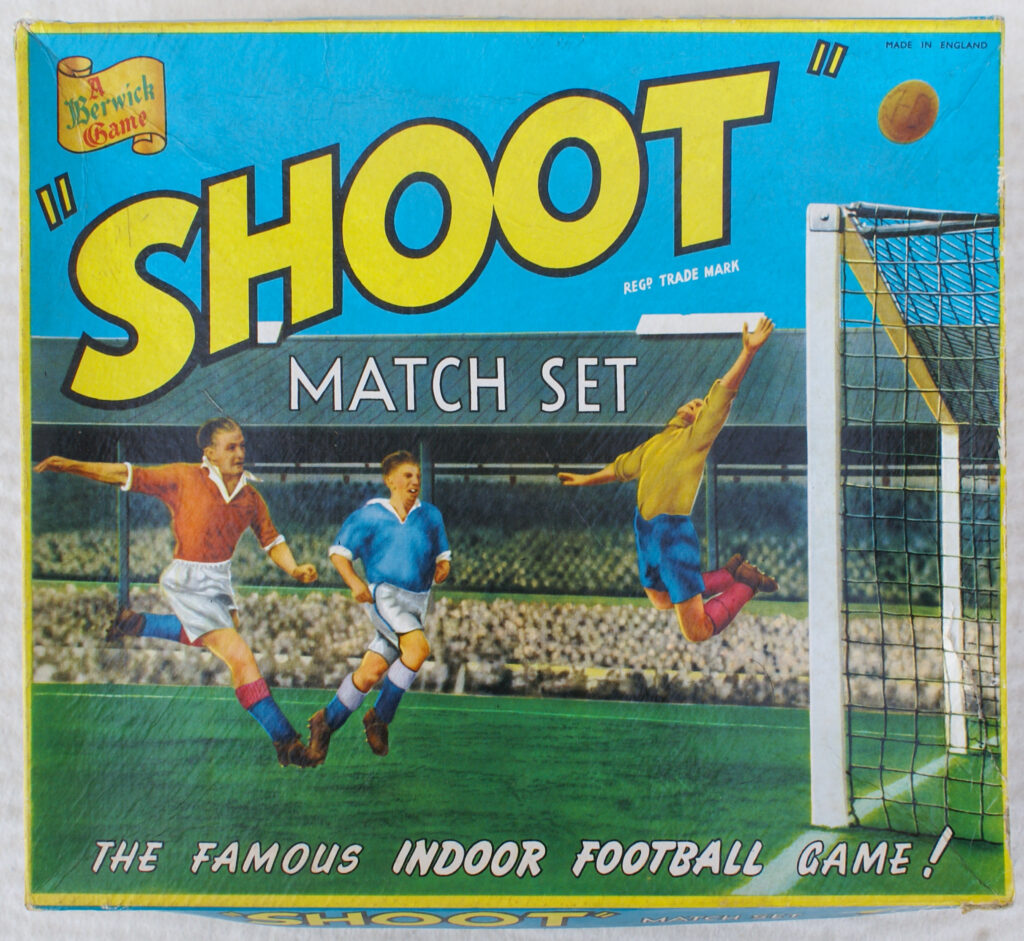
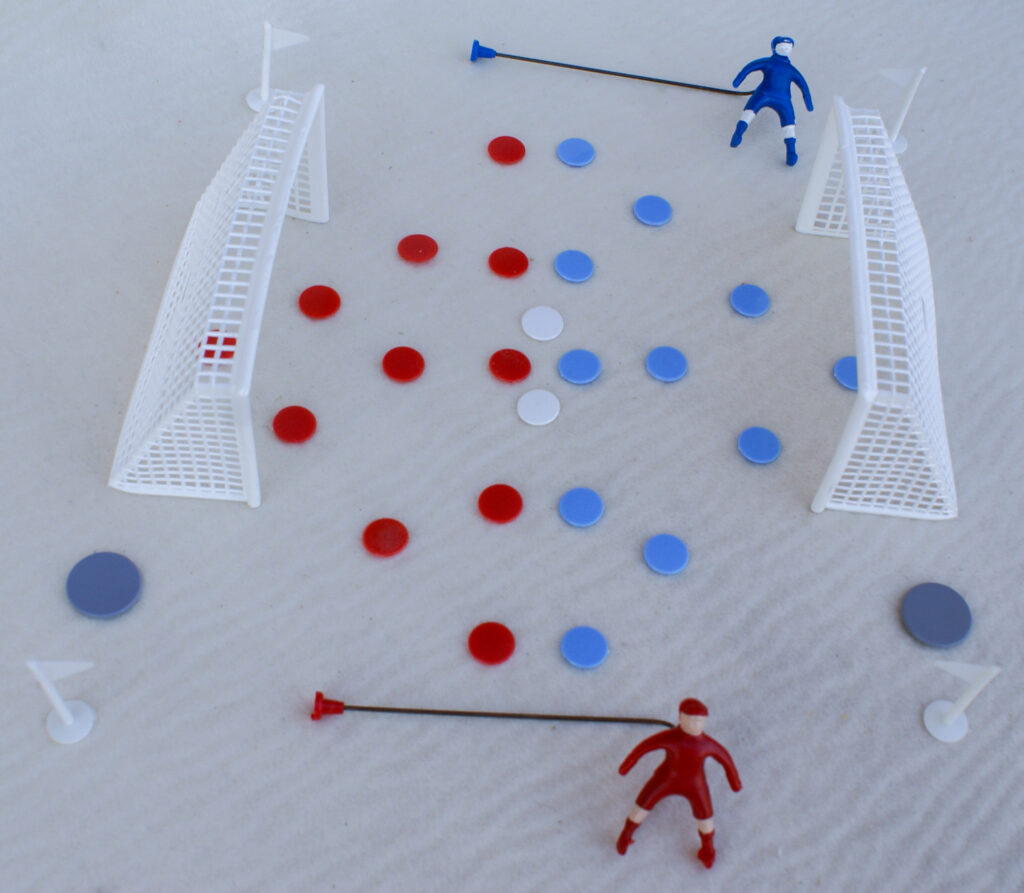
Berwick continued producing and selling this popular tiddlywinks football/soccer game of SHOOT into the 1970s (estimated).
Navigating Chapters
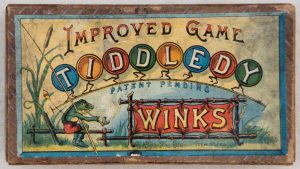
8 ❖ Conquering the U.S. • Tiddledy Winks
Now let us return to 1890. The name of the game quickly fell into the public domain starting in 1890 (though in the United States,
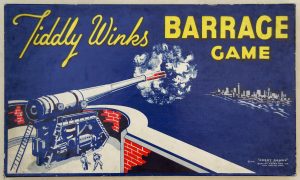
11 ❖ Tiddlywinks • Goes to War
Yes, tiddlywinks went to war. John Alfred Rivington patented a naval/land battle tiddlywinks game in 1899 in the UK. According to the patent: This invention
© 2023 North American Tiddlywinks Association. All Rights Reserved | Hosted at Elementor.Cloud
![[+template:(Tucker Tw ID • [+xmp:title+] — publisher • [+iptc:source+] — title • [+xmp:headline])+]](https://tiddlywinks.org/wp-content/uploads/2023/01/service-copyright-hprcatcard-18-70-18-97-SI-M-SJ-UT-TI-O-18701897SIM-SJUTTIO-CC18701897SIM-SJUTTIO0867-1024x658.jpg)
![Tucker Tw ID • HOR-04v1c1 — AGPI ID • G-29863c1 — publisher • E. I. H. [E. I. Horsman] — title • RING-A-PEG THE NEW GAME — notes • Patent applied for.](https://tiddlywinks.org/wp-content/uploads/2023/01/HOR-04v1c1-_-G-29863c1-_-Horsman-E-I-HOR-_-RING-A-PEG-THE-NEW-GAME-_-DSC00498-483x1024.jpg)
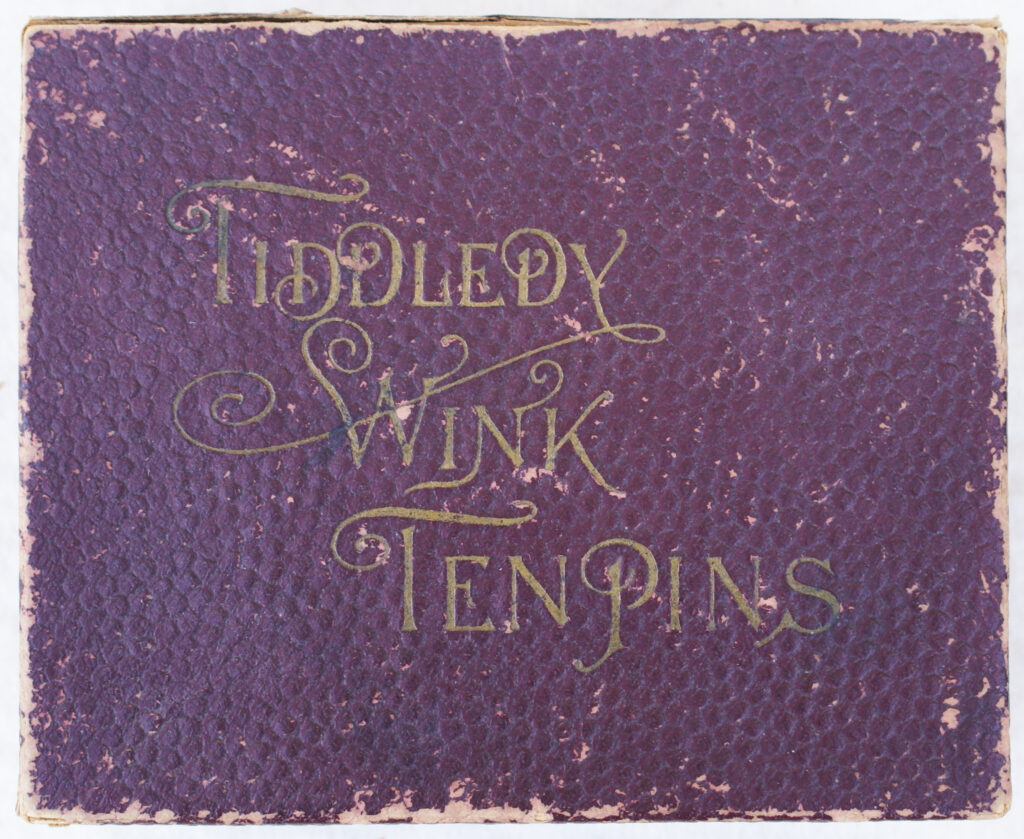
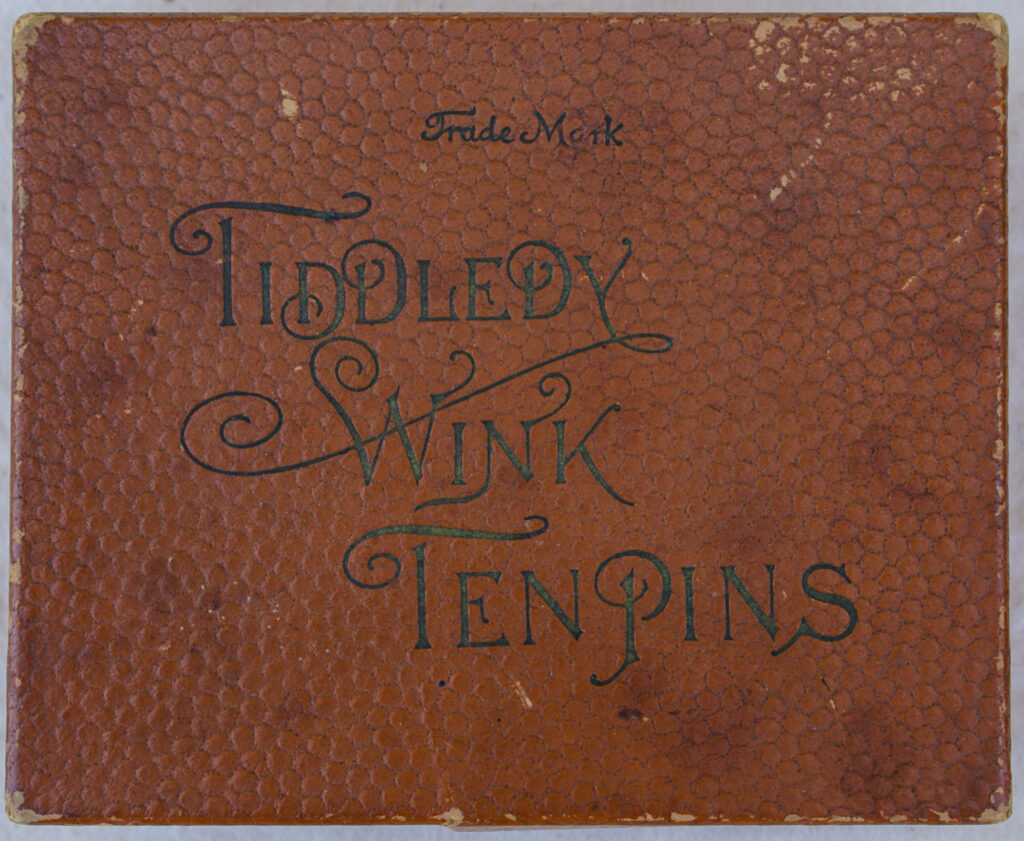
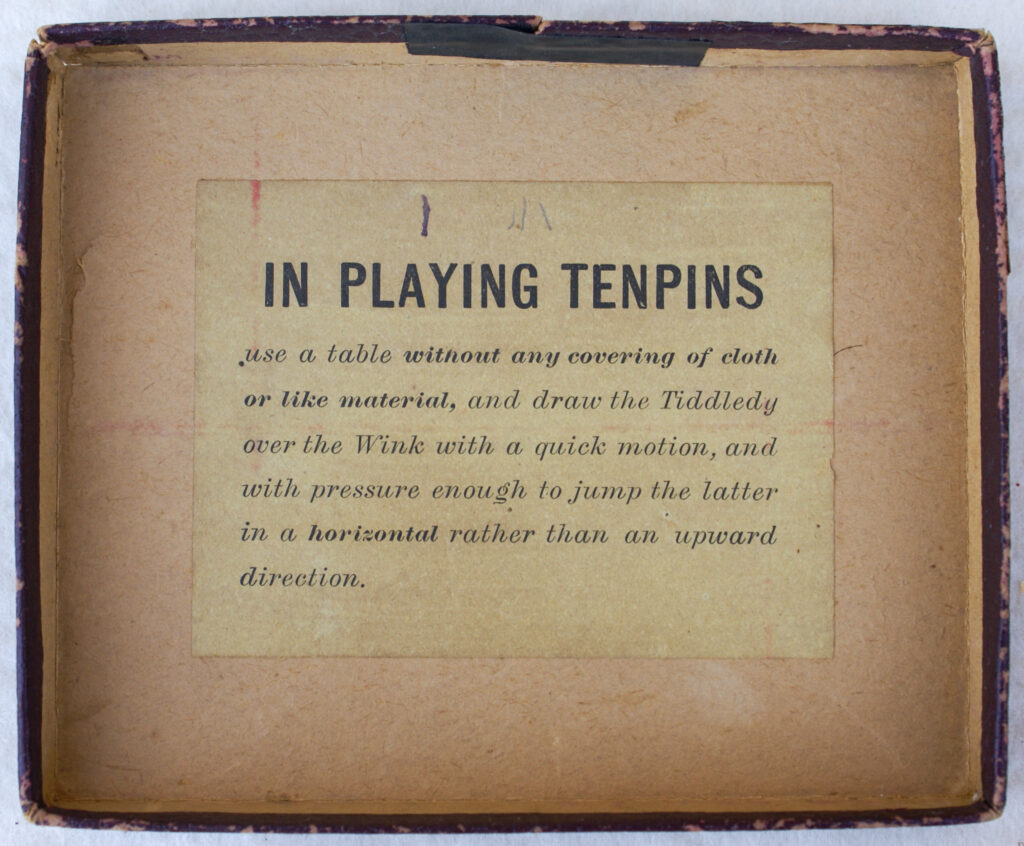
![[+template:(Tucker Tw ID • [+xmp:title+] — publisher • [+iptc:source+] — title • [+xmp:headline])+]](https://tiddlywinks.org/wp-content/uploads/2023/01/1891-US-copyright-card-num-8736-item-Tiddledy-Wink-Hop-Scotch-service-copyright-hprcatcard-18-70-18-97-CL-I-CO-G-18701897CLI-COG-CC18701897CLI-COG0991-768x429.jpg)
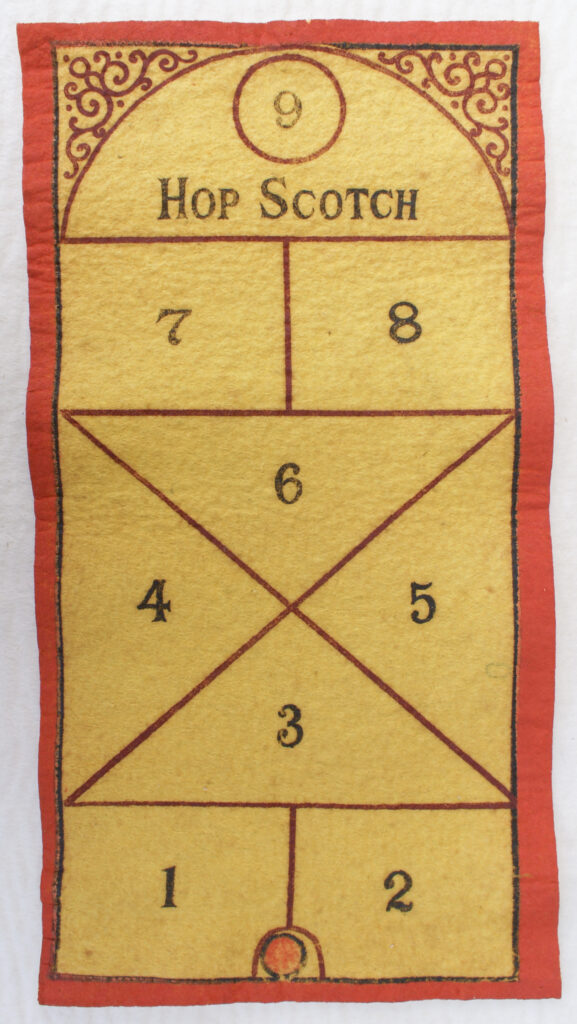
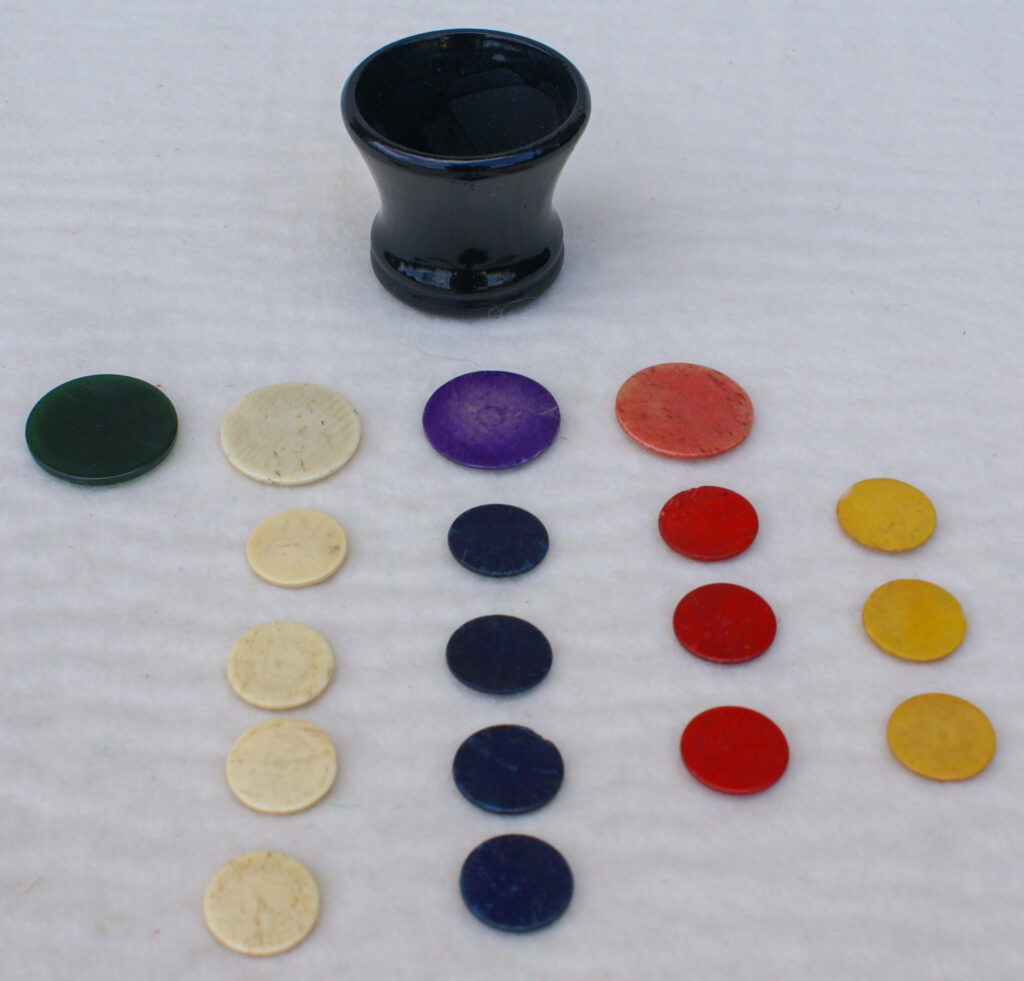

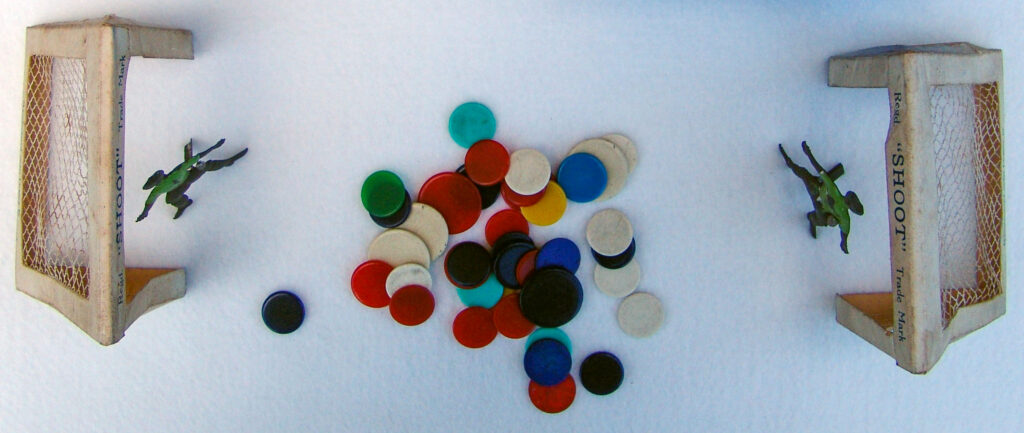
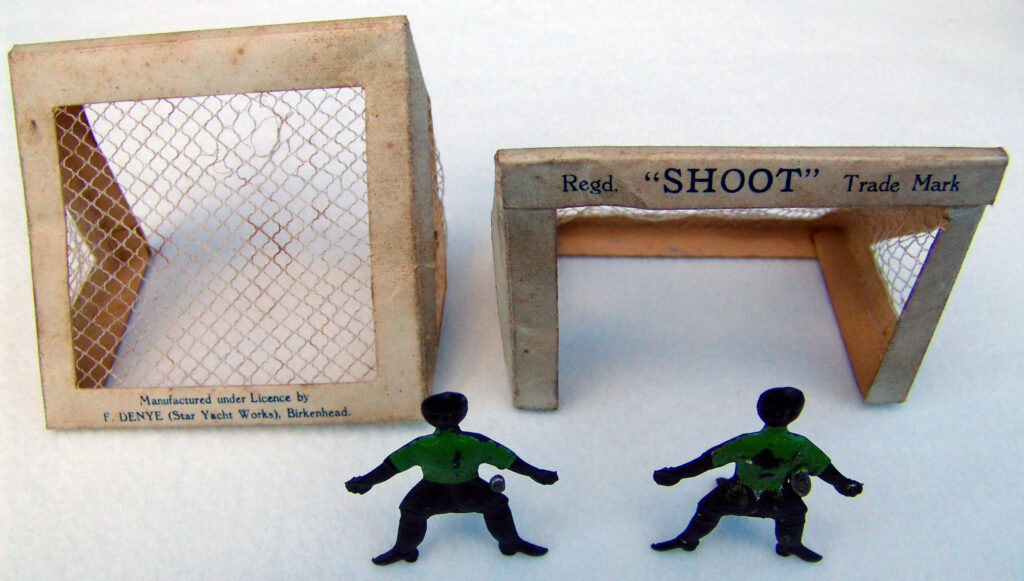
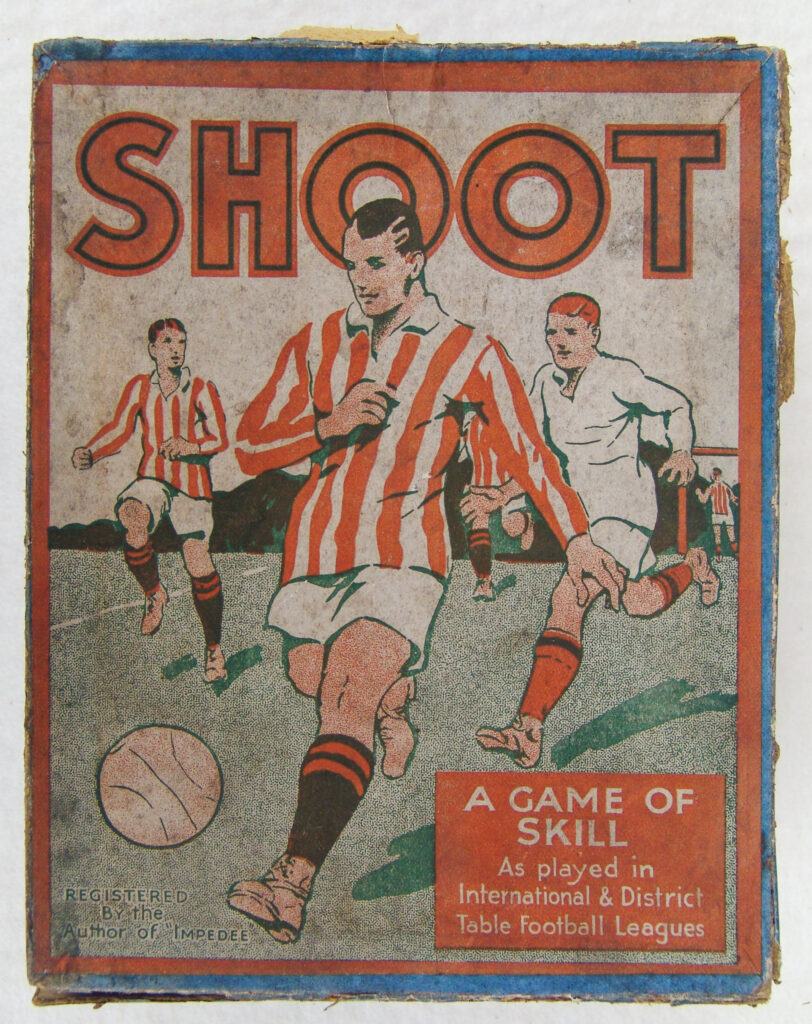
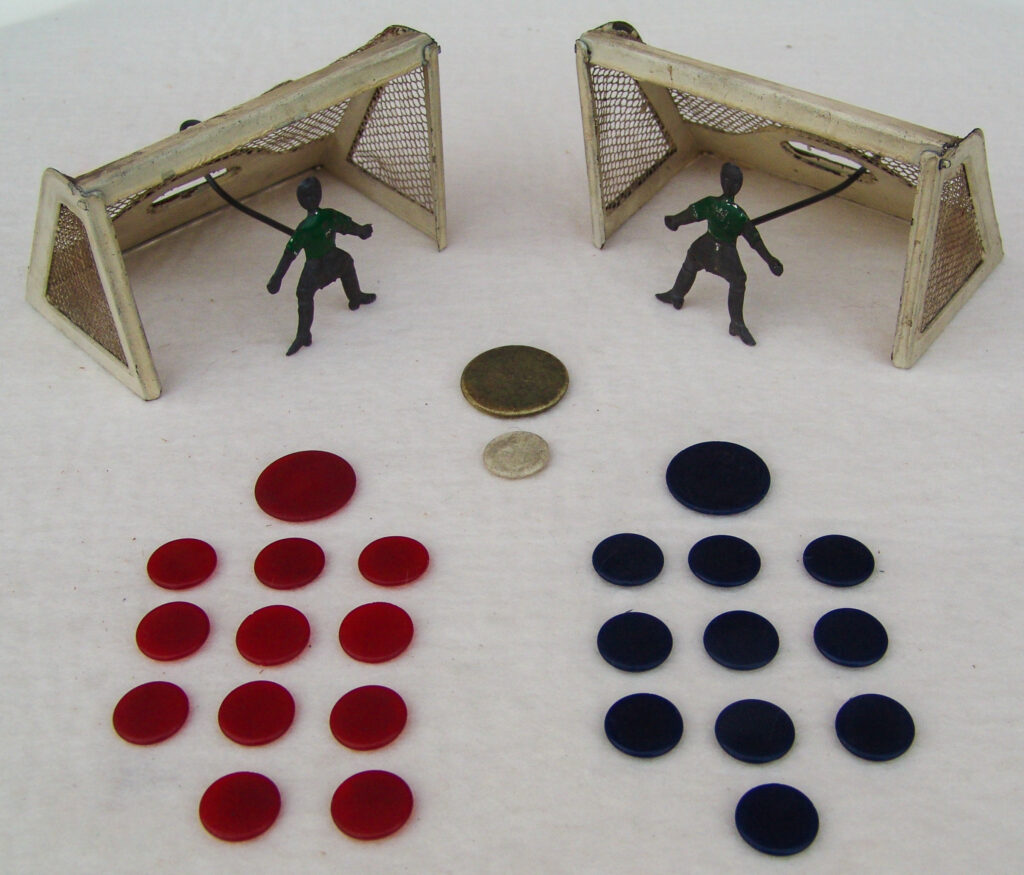
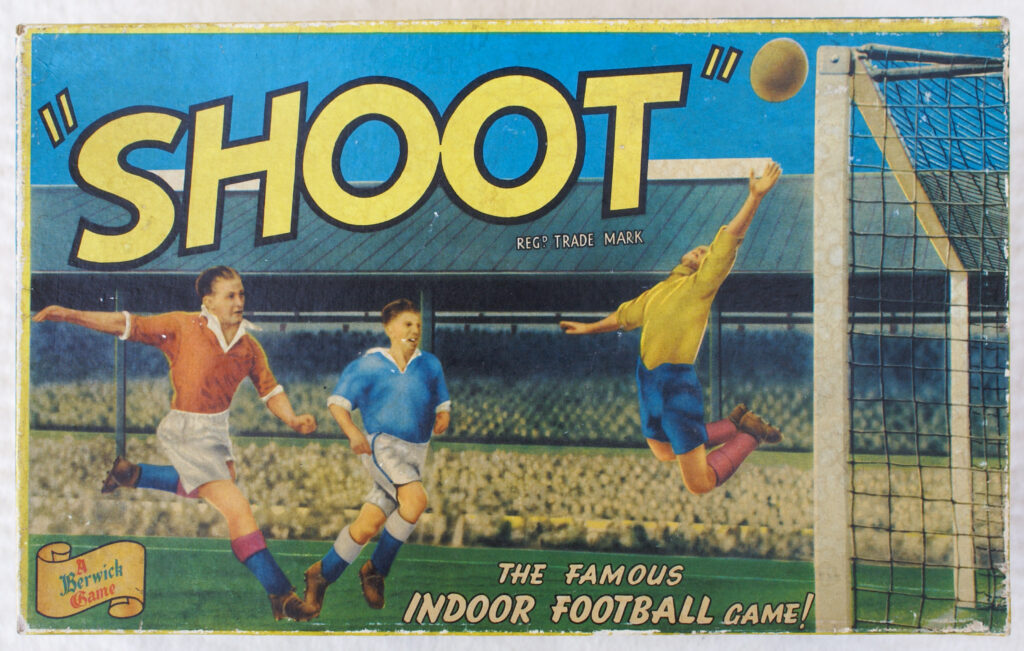
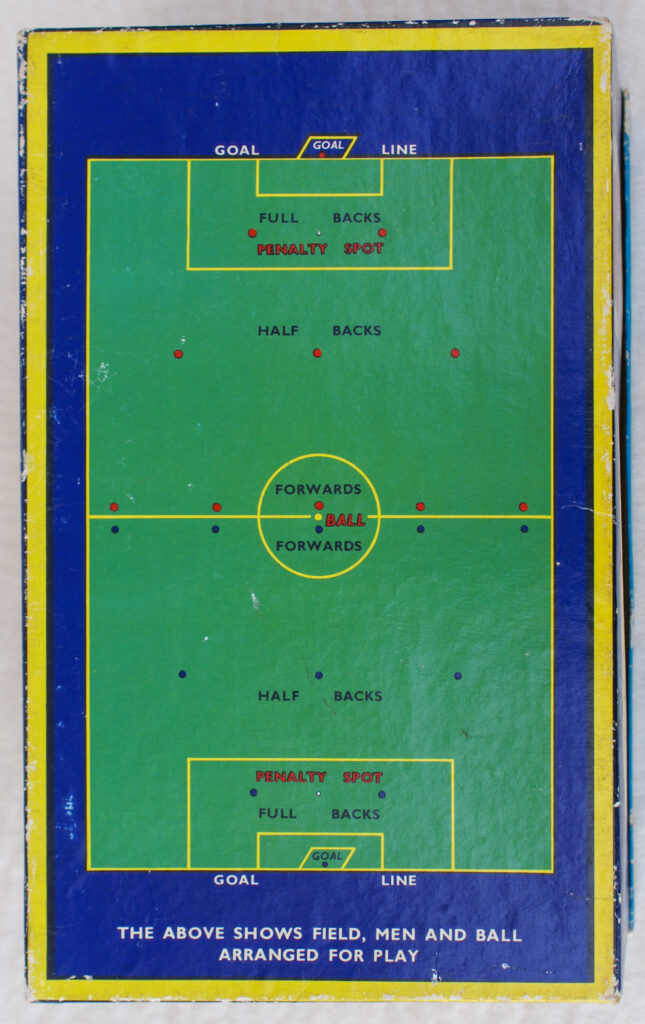
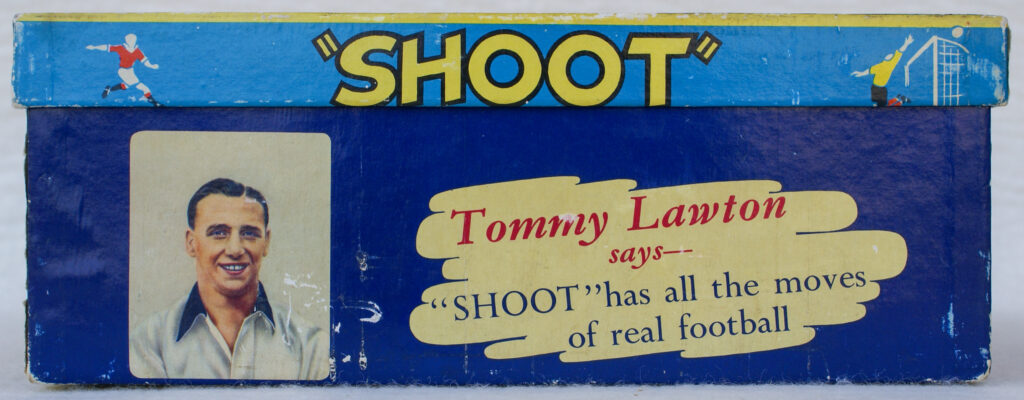
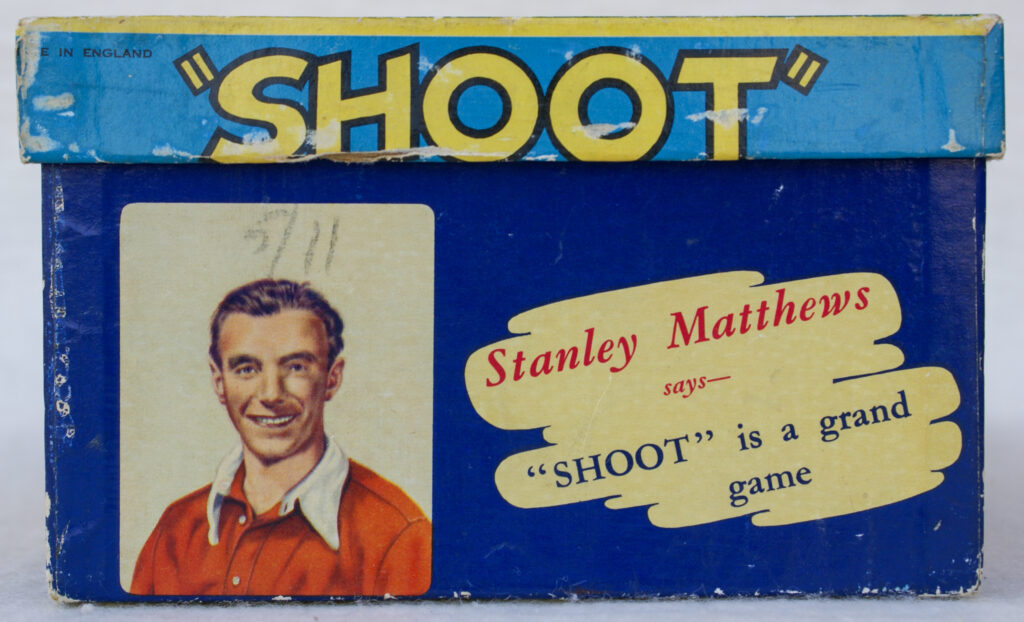
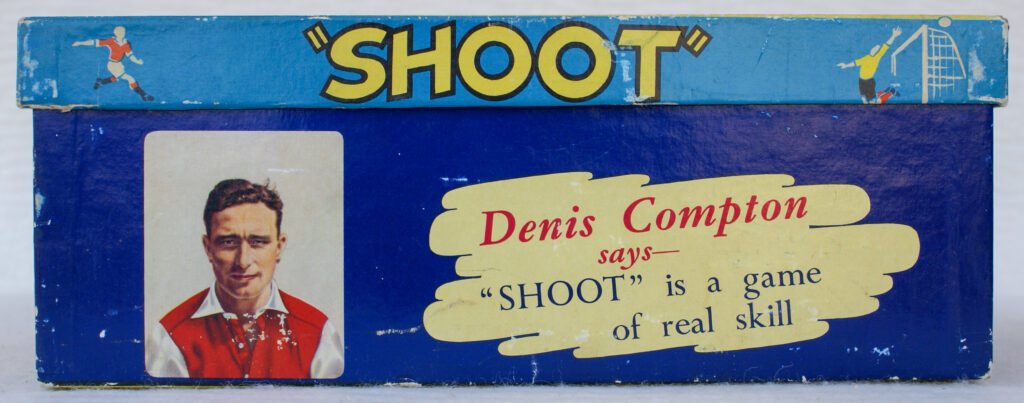
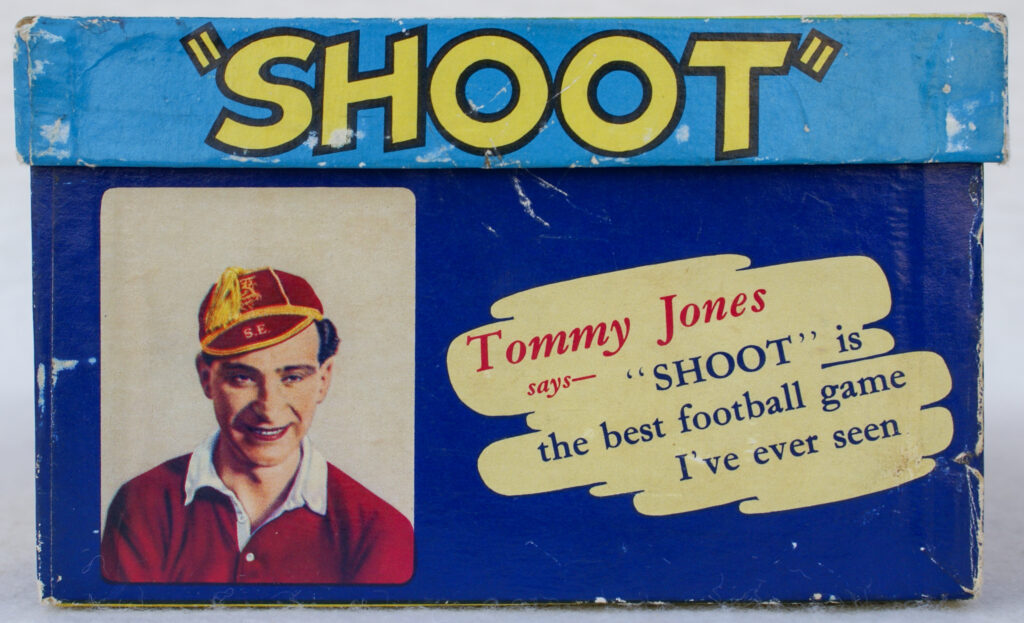
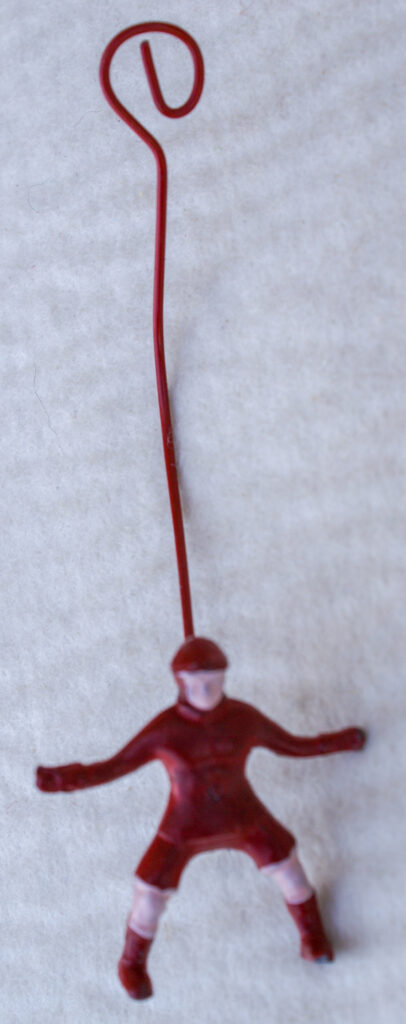
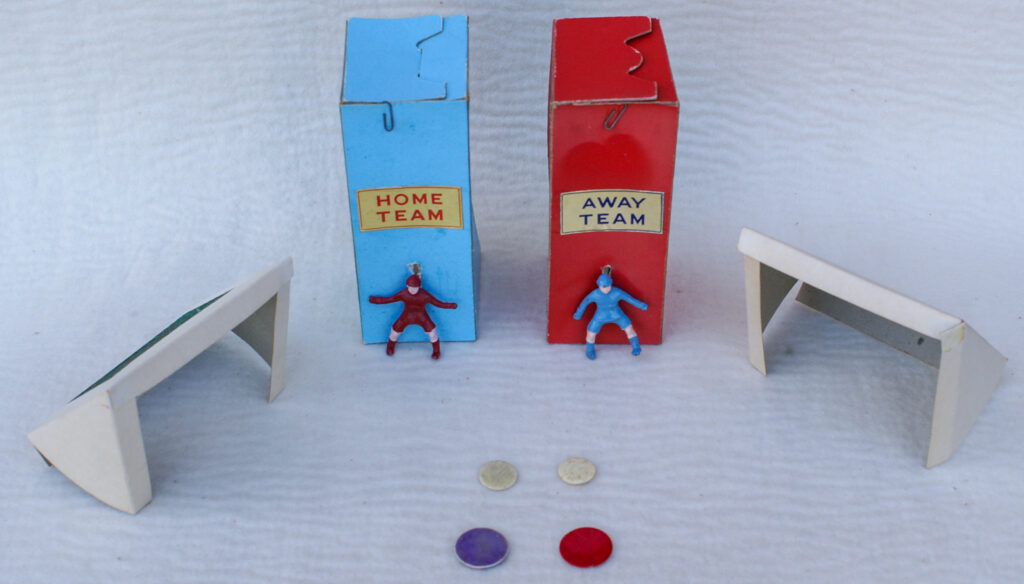
![[+template:(Tucker Tw ID • [+xmp:title+] — publisher • [+iptc:source+] — title • [+xmp:headline])+]](https://tiddlywinks.org/wp-content/uploads/2023/01/1955-12-16-Coventry-Evening-Telegraph-England-page-6-col-1-re-Shoot-football-game-from-BNA-BL_0000769_19551216_077_0006-crop-to-ad-1.jpg)
